Liver Injury by Carbon Tetrachloride Intoxication in 16 Patients Treated with Forced Ventilation to Accelerate Toxin Removal via the Lungs: A Clinical Report
Abstract
1. Introduction
2. Literature Search
3. Historical Cases of CCl4 Poisoning and Liver Injury Caused by CCl4
4. Actual Patients with CCl4 Poisoning and CO2-Induced Hyperventilation
5. Clinical and Experimental Challenges of CO2-Induced Hyperventilation
5.1. Clinical Data
5.2. Experimental Results
6. CCl4 and Hepatic Microsomal CYP 2E1
6.1. Carbon Tetrachloride
6.2. Cytochrome P450 2E1
6.2.1. Molecular Oxygen
6.2.2. Destabilization and Suicidal Inactivation
6.2.3. Down-Regulation by Glucose
6.2.4. Inhibition by Cimetidine
6.2.5. Up-Regulation by Alcohol
6.2.6. Preexisting Liver Disease
7. Liver Transplantation
8. Summarized Considerations of CCl4 Poisoning for Clinical Practice
9. Conclusions
Acknowledgments
Conflicts of Interest
References
- Smillie, W.G.; Pessao, S.B. Treatment of hookworm disease with carbon tetrachloride. Am. J. Hyg. 1923, 3, 35–45. [Google Scholar] [CrossRef]
- Plaa, G.L. Chlorinated methanes and liver injury: Highlights of the past 50 years. Ann. Rev. Pharmacol. Toxicol. 2000, 40, 43–65. [Google Scholar] [CrossRef] [PubMed]
- Recknagel, R.O.; Glende, E.A., Jr.; Dolak, J.A.; Waller, R.L. Mechanisms of carbon tetrachloride toxicity. Pharmacol. Ther. 1989, 43, 139–154. [Google Scholar] [CrossRef]
- Weber, L.W.D.; Boll, M.; Stampfl, A. Hepatotoxicity and mechanism of action of haloalkanes: Carbon tetrachloride as a toxicological model. Crit. Rev. Toxicol. 2003, 33, 105–136. [Google Scholar] [CrossRef] [PubMed]
- Stoyanovsky, D.A.; Cederbaum, A.I. Metabolism of carbon tetrachloride to trichloromethyl radical: An ESR and HPLC-EC study. Chem. Res. Toxicol. 1999, 12, 730–736. [Google Scholar] [CrossRef] [PubMed]
- Raucy, J.L.; Kraner, J.C.; Lasker, J.M. Bioactivation of halogenated hydrocarbons by cytochrome P4502E1. Crit. Rev. Toxicol. 1993, 23, 1–20. [Google Scholar] [CrossRef] [PubMed]
- Al-Rasheed, N.M.; Fadda, L.M.; Ali, H.M.; Abdel Baky, N.A.; El-Orabi, N.F.; Al-Rasheed, N.M.; Yacoub, H.I. New mechanism in the modulation of carbon tetrachloride hepatotoxicity in rats using different natural antioxidants. Toxicol. Mech. Methods 2016, 26, 243–250. [Google Scholar] [CrossRef] [PubMed]
- Teschke, R.; Vierke, W.; Goldermann, L. Carbon tetrachloride (CCl4) levels and serum activities of liver enzymes following acute CCl4 intoxication. Toxicol. Lett. 1983, 17, 175–180. [Google Scholar] [CrossRef]
- Vierke, W.; Gellert, J.; Teschke, R. Head-space gas chromatographic analysis for rapid quantitative determination of carbon tetrachloride in blood and liver of rats. Arch. Toxicol. 1982, 51, 91–99. [Google Scholar] [CrossRef]
- Goldermann, L.; Gellert, J.; Teschke, R. Quantitative assessment of carbon tetrachloride levels in human blood by head-space gas chromatography: Application in a case of suicidal carbon tetrachloride intoxication. Intensive Care Med. 1983, 9, 131–135. [Google Scholar] [CrossRef] [PubMed]
- Hasumura, Y.; Teschke, R.; Lieber, C.S. Increased carbon tetrachloride hepatotoxicity, and its mechanism, after chronic ethanol consumption. Gastroenterology 1974, 66, 226–234. [Google Scholar]
- Lieber, C.S. Cytochrome P-4502E1: Its physiological and pathological role. Physiol. Rev. 1997, 77, 517–544. [Google Scholar] [CrossRef] [PubMed]
- Teschke, R.; Matsuzaki, S.; Ohnishi, K.; DeCarli, L.M.; Lieber, C.S. Microsomal ethanol oxidizing system (MEOS): Current status of its characterization and its role. Alcohol. Clin. Exp. Res. 1977, 1, 7–15. [Google Scholar] [CrossRef] [PubMed]
- Teschke, R.; Ohnishi, K.; Hasumura, Y.; Lieber, C.S. Hepatic microsomal ethanol oxidizing system: Isolation and reconstitution. In Microsomes and Drug Oxidations; Ullrich, V., Roots, I., Hildebrandt, A., Estabrook, R.W., Conney, A.H., Eds.; Pergamon Press: Oxford, UK, 1977; pp. 103–110. [Google Scholar]
- Petersen, D.R.; Atkinson, N.; Hjelle, J.J. Increase in hepatic microsomal ethanol oxidation by a single dose of ethanol. J. Pharmacol. Exp. Ther. 1982, 221, 275–281. [Google Scholar] [PubMed]
- Teschke, R.; Hauptmeier, K.H.; Frenzel, H. Effect of an acute dose of ethanol on the hepatotoxicity due to carbon tetrachloride. Liver Int. 1983, 3, 100–109. [Google Scholar] [CrossRef]
- Docherty, J.F.; Burgess, E. The action of carbon tetrachloride on the liver. Br. Med. J. 1922, 2, 907–908. [Google Scholar] [CrossRef] [PubMed]
- McGuire, L.W. Carbon tetrachloride poisoning. J. Am. Med. Assoc. 1932, 99, 988–989. [Google Scholar] [CrossRef]
- Lehnherr, E.R. Acute carbon tetrachloride poisoning: Report of a case. Arch. Int. Med. 1935, 56, 98–104. [Google Scholar] [CrossRef]
- Moon, H.D. The pathology of fatal carbon tetrachloride poisoning with special reference to the histogenesis of the hepatic and renal lesions. Am. J. Pathol. 1950, 26, 1041–1057. [Google Scholar] [PubMed]
- Jennings, R.B. Fatal fulminant acute carbon tetrachloride poisoning. Arch. Pathol. 1955, 59, 269–284. [Google Scholar]
- Guild, W.R.; Young, J.V.; Merrill, J.P. Anuria due to carbon tetrachloride intoxication. Ann. Intern. Med. 1958, 48, 1221–1227. [Google Scholar] [CrossRef] [PubMed]
- New, P.S.; Lubash, G.D.; Scherr, L.; Rubin, A.L. Acute renal failure: Associated with carbon tetrachloride intoxication. J. Am. Med. Assoc. 1962, 181, 197–200. [Google Scholar] [CrossRef]
- Fischl, J.; Labi, M. Gas chromatic determination of carbon tetrachloride in a case of accidental poisoning. Isr. J. Med. Sci. 1966, 2, 84–85. [Google Scholar] [PubMed]
- Dume, T.; Herms, W.; Schröder, E.; Wetzels, E. Klinik und Therapie der Tetrachlorkohlenstoffvergiftung. Dtsch. Med. Wochenschr. 1969, 94, 1646–1651. [Google Scholar] [CrossRef] [PubMed]
- Kennaugh, R.C. Carbon tetrachloride overdose. A case report. S. Afr. Med. J. 1975, 49, 635–636. [Google Scholar] [PubMed]
- Hadi, S.F.; Mikatti, N.E. Acute carbon tetrachloride poisoning. Intensive Care Med. 1981, 7, 203–204. [Google Scholar] [CrossRef] [PubMed]
- Schäfer, K.; Ukida, M.; Bode, C. Aminoacid concentration in plasma of patients with liver necrosis after carbon tetrachloride poisoning (three cases). Dtsch. Med. Wochenschr. 1982, 107, 860–864. [Google Scholar] [CrossRef] [PubMed]
- Truss, C.D.; Killenberg, P.G. Treatment of carbon tetrachloride poisoning with hyperbaric oxygen. Gastroenterology 1982, 82, 767–769. [Google Scholar] [PubMed]
- Fogel, R.P.; Davidman, M.; Poleski, M.H.; Spanier, A.H. Carbon tetrachloride poisoning treated with hemodialysis and total parenteral nutrition. Can. Med. Assoc. Med. J. 1983, 128, 560–561. [Google Scholar]
- Ruprah, M.; Mant, T.G.K.; Flanagan, R.J. Acute carbontetrachloride poisoning in 19 patients: Implications for diagnosis and treatment. Lancet 1985, 325, 1027–1029. [Google Scholar] [CrossRef]
- Hoshino, T.; Komatsu, M.; Ono, T.; Funaoka, M.; Kato, J.; Ishii, T.; Kuramitsu, T.; Miura, K.; Masamune, O.; Hojo, H. A case of acute carbon tetrachloride poisoning. Acta Hepatol. 1994, 35, 882–886. [Google Scholar] [CrossRef][Green Version]
- Mydlík, M.; Derzsiová, K.; Frank, K. Renal replacement therapy in acute poisonings—One center experience. Prz. Lek. 2013, 70, 381–385. [Google Scholar] [PubMed]
- Teschke, R. Intoxications by aliphatic halogenated hydrocarbons: Hepatotoxic risks for patients and clinical issues including role of CO2-induced hyperventilation as therapy option. J. Clin. Exp. Toxicol. 2018, 2, 20–24. [Google Scholar]
- Draeger. Draeger Gas Detection Devise. Available online: https://www.gasdetectionwarehouse.com/draeger-gas-detector-tubes-10-per-box-halogenated-hydrocarbons/ (accessed on 8 March 2018).
- Teschke, R. Forced ventilation as therapy for acute intoxications due to halogenated aliphatic hydrocarbons. Experience in 60 patients. Therapiewoche 1987, 37, 339–344. [Google Scholar]
- Pebay-Peyroula, F.; Nicaise, A.M. Élimination pulmonaire des toxiques-mesure-applications toxicologiques. J. Eur. Toxicol. 1970, 5, 300–308. [Google Scholar]
- Kindler, U.; Goeckenjahn, G.; Barthels, F.; Grabensee, B. Hyperventilationstherapie bei Patienten mit Vergiftungen durch Halogenkohlenwasserstoffewasserstoffe. Intensivmedizin 1977, 14, 362–367. [Google Scholar]
- Lemburg, P.; Sprock, I.; Bretschneider, A.; Storm, W.; Göbel, U. A new concept of therapy in accidental intoxications with halogenated hydrocarbons. Vet. Hum. Toxicol. 1979, 21, S37–S40. [Google Scholar]
- Teschke, R.; Jehle, J.; Altrogge, A. Leberenzymveränderungen bei Vergiftungen durch halogenierte Kohlenwasserstoffe unter Hyperventilationstherapie. In Pädiatrische Intensivmedizin II; Lemburg, P., Ed.; Thieme Stuttgart: Stuttgart, Germany, 1981; pp. 39–48. [Google Scholar]
- Pothmann, R.; Lemburg, P.; Sprock, I.; Göbel, U. Hyperventilationstherapie bei oraler Vergiftung mit halogenierten Kohlenwasserstoffen. In Pädiatrische Intensivmedizin II; Lemburg, P., Ed.; Thieme Stuttgart: Stuttgart, Germany, 1981; pp. 229–233. [Google Scholar]
- Teschke, R.; Goldermann, L.; Vierke, W.; Hanrath, R.D.; Gellert, J. Forcierte Ventilation. In Aktuelle Intensivmedizin 1, Diagnose, Verlaufskontrolle und Therapie Schwerer Exogener Vergiftungen; Deutsch, E., Kleinberger, G., Ritz, R., Schuster, H.P., Eds.; Schattauer: Stuttgart, Germany, 1984; pp. 117–131. [Google Scholar]
- Gellert, J.; Goldermann, L.; Teschke, R. Effect of CO2-induced hyperventilation on carbon tetrachloride (CCl4) levels following acute CCl4 poisoning. Intensive Care Med. 1983, 9, 333–337. [Google Scholar] [CrossRef] [PubMed]
- Frenzel, H.; Heidenreich, T.; Gellert, J.; Teschke, R. Protective effect of CO2-induced hyperventilation on the hepatotoxicity elicited by carbon tetrachloride. Liver Int. 1982, 2, 376–384. [Google Scholar] [CrossRef]
- Gellert, J.; Frenzel, H.; Heidenreich, T.; Goldermann, L.; Vierke, W.; Teschke, R. Effektivität der CO2-induzierten Hyperventilationstherapie durch halogenierte Kohlenwasserstoffe. Intensivmedizin 1982, 19, 293–297. [Google Scholar]
- Morgan, A.; Black, A.; Belcher, D.R. The excretion in breath of some aliphatic halogenated hydrocarbons following administration by inhalation. Ann. Occup. Hyg. 1970, 14, 219–233. [Google Scholar]
- McLean, A.E.M. Drugs, diet and liver injury. In Drugs and the Liver; Gerok, W., Sickinger, K., Eds.; Schattauer: Stuttgart, Germany, 1975; pp. 143–148. [Google Scholar]
- Zangar, R.C.; Benson, J.M.; Burnett, V.L.; Springer, D.L. Cytochrome P450 2E1 is the primary enzyme responsible for low-dose carbon tetrachloride metabolism in human liver microsomes. Chem. Biol. Interact. 2000, 15, 233–243. [Google Scholar] [CrossRef]
- Park, S.M.; Park, E.J.; Ko, G.; Kim, J.; Sohn, D.H. A study for regulation of ethanol-inducible P450 (CYP2E1) on CCl4-induced hepatic damage. Arch. Pharm. Res. 1995, 18, 179. [Google Scholar] [CrossRef]
- Sohn, D.H.; Yun, Y.P.; Park, S.S.; Veech, R.L.; Song, B.J. Post-translational reduction of cytochrome P450 2E1 by CCl4, its substrate. Biochem. Biophys. Res. Commun. 1991, 179, 449–454. [Google Scholar] [CrossRef]
- Manno, M.; De Matteis, F.; King, L.J. The mechanism of suicidal reductive inactivation of microsomal cytochrome P450 by carbon tetrachloride. Biochem. Pharmacol. 1988, 38, 1001–1007. [Google Scholar]
- Poyer, J.L.; Floyd, R.A.; McCay, P.B.; Janzen, E.G.; Davis, E.R. Spin-trapping of the trichloromethyl radical produced during enzyme NADPH oxidation in the presence of carbon tetrachloride or bromotrichloromethane. Biochem. Biophys. Acta 1978, 539, 402–409. [Google Scholar] [CrossRef]
- Ibrahim, Z.S.; Ishizuka, M.; Soliman, M.; ElBohi, K.; Sobhy, W.; Muzandu, K.; Elkattawy, A.M.; Sakamoto, K.Q.; Fujita, S. Protection by Nigella sativa against carbon tetrachloride-induced downregulation of hepatic cytochrome P450 isozymes in rats. Jpn. J. Vet. Res. 2008, 56, 119–128. [Google Scholar] [PubMed]
- McCay, P.B.; Lai, E.K.; Poyer, J.L.; DuBose, C.M.; Janzen, E.G. Oxygen and carbon-centered free radical formation during carbon tetrachloride metabolism. J. Biol. Chem. 1984, 259, 2135–2143. [Google Scholar] [PubMed]
- Tierney, D.J.; Haas, A.; Koop, D.R. Degradation of cytochrome P450 2E1: Selective loss after labilization of the enzyme. Arch. Biochem. Biophys. 1992, 293, 9–16. [Google Scholar] [CrossRef]
- Li, X.X.; Zheng, Q.C.; Wang, Y.; Zhang, H.X. Theoretical insights into the reductive metabolism of CCl4 by cytochrome P450 enzymes and the CCl4-dependent suicidal inactivation of P450. Dalton Trans. 2014, 43, 14833–14840. [Google Scholar] [CrossRef] [PubMed]
- Pischik, E.; Kauppinen, R. An update of clinical management of acute intermittent porphyria. Appl. Clin. Genet. 2015, 8, 201–214. [Google Scholar] [CrossRef] [PubMed]
- Tschudy, D.P.; Welland, F.H.; Collins, A. The effect of carbohydrate feeding on the induction of delta-aminolevulinic acid synthetase. Metabolism 1964, 13, 396–406. [Google Scholar] [CrossRef]
- Puy, H.; Deybach, J.C. Haem biosynthesis and excretion of porphyrins. In Textbook of Hepatology, 3rd ed.; Rodés, J., Benhamou, J.-P., Blei, A., Reichen, J., Rizzetto, M., Eds.; Wiley: Hoboken, NJ, USA, 2007; pp. 207–214. Available online: http://www.gastrohep.com/ebooks/rodes/Rodes_2_3_10.pdf (accessed on 8 March 2018).
- Levin, W.; Jacobson, M.; Kutzman, R. Incorporation of radioactive-delta-aminolevulinic acid into microsomal cytochrome P450. Arch. Biochem. Biophys. 1972, 148, 262–269. [Google Scholar] [CrossRef]
- Homann, J.; Rotter, S.; Schneider, S.; Röttger, P.; Kratz, F.; Kroker, R.; Kamenisch, W.; Paul, F.; Matthes, K.J. Influence of cimetidine on CCl4-induced liver injury and survival in rats. Biochem. Pharmacol. 1985, 34, 415–416. [Google Scholar] [CrossRef]
- Das, J.; Ghosh, J.; Manna, P.; Sil, P.C. Taurine protects acetaminophen-induced oxidative damage in mice kidney through APAP urinary excretion and CYP2E1 inactivation. Toxicology 2010, 269, 24–34. [Google Scholar] [CrossRef] [PubMed]
- Teschke, R.; Vierke, W.; Gellert, J. Effect of ethanol on carbon tetrachloride levels and hepatotoxicity after acute carbon tetrachloride poisoning. Arch. Toxicol. 1984, 56, 78–82. [Google Scholar] [CrossRef] [PubMed]
- Teschke, R. Alcoholic steatohepatitis (ASH) and acute alcoholic hepatitis (AH): Cascade of events, clinical features, and pharmacotherapy options. Exp. Opin. Pharmacother. 2018, in press. [Google Scholar]
- Lauschke, V.M.; Ingelman-Sundberg, M. The importance of patient-specific factors for hepatic drug response and toxicity. Int. J. Mol. Sci. 2016, 17, 1714. [Google Scholar] [CrossRef] [PubMed]
- Jiménez, W.; Clària, J.; Arroyo, V.; Rodés, J. Review article: Carbon tetrachloride induced cirrhosis in rats: A useful tool for investigating the pathogenesis of ascites in chronic liver disease. J. Gastroenterol. Hepatol. 1992, 7, 90–97. [Google Scholar] [CrossRef] [PubMed]
- Delire, B.; Stärkel, P.; Leclercq, I. Animal models for fibrotic liver diseases: What we have, what we need, and what is under development. J. Clin. Transl. Hepatol. 2015, 3, 53–66. [Google Scholar] [CrossRef] [PubMed]
- Proctor, E.; Chatamra, K. High yield micronodular cirrhosis in the rat. Gastroenterology 1982, 83, 1183–1190. [Google Scholar] [PubMed]
- Leung, T.M.; Nieto, N. CYP2E1 and oxidant stress in alcoholic and non-alcoholic fatty liver disease. J. Hepatol. 2013, 58, 395–398. [Google Scholar] [CrossRef] [PubMed]
- Nehoda, H.; Wieser, C.; Koller, J.; Konigsrainer, K.A.; Battista, H.J.; Vogel, W.; Margreiter, R. Recurrent liver failure with severe rhabdomyolysis after liver transplantation for carbon tetrachloride intoxication. Hepatogastroenterology 1998, 45, 191–195. [Google Scholar] [PubMed]


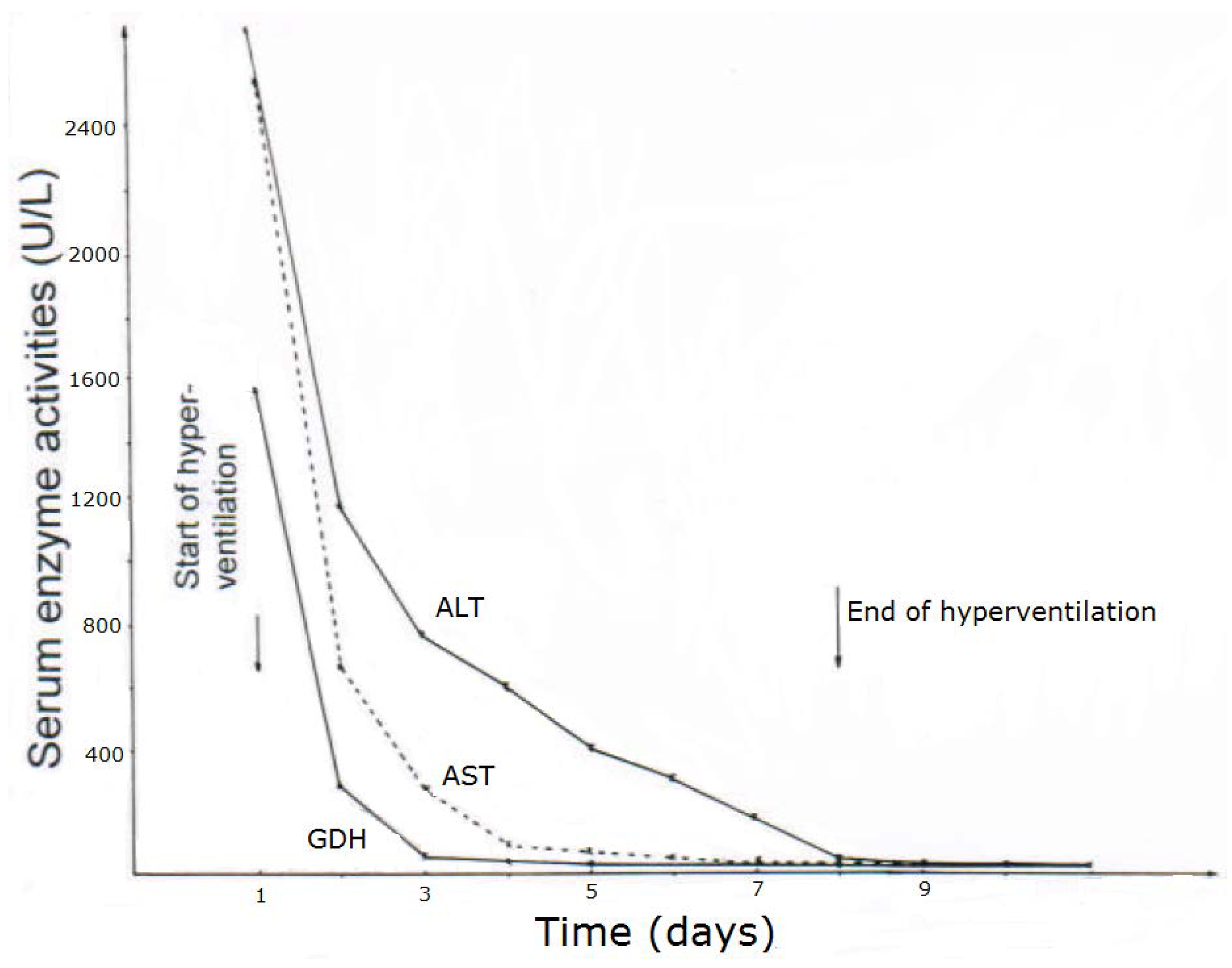
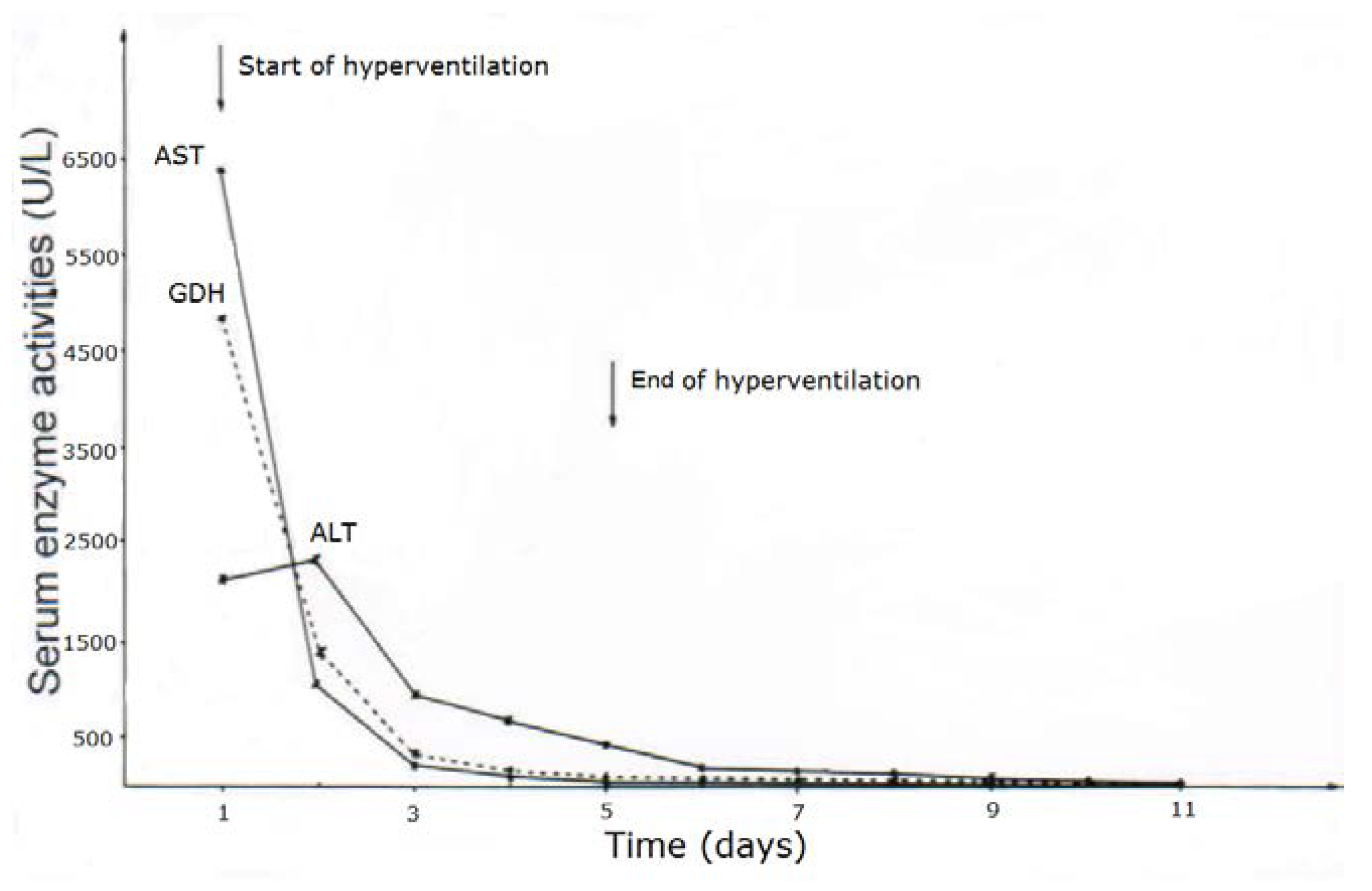
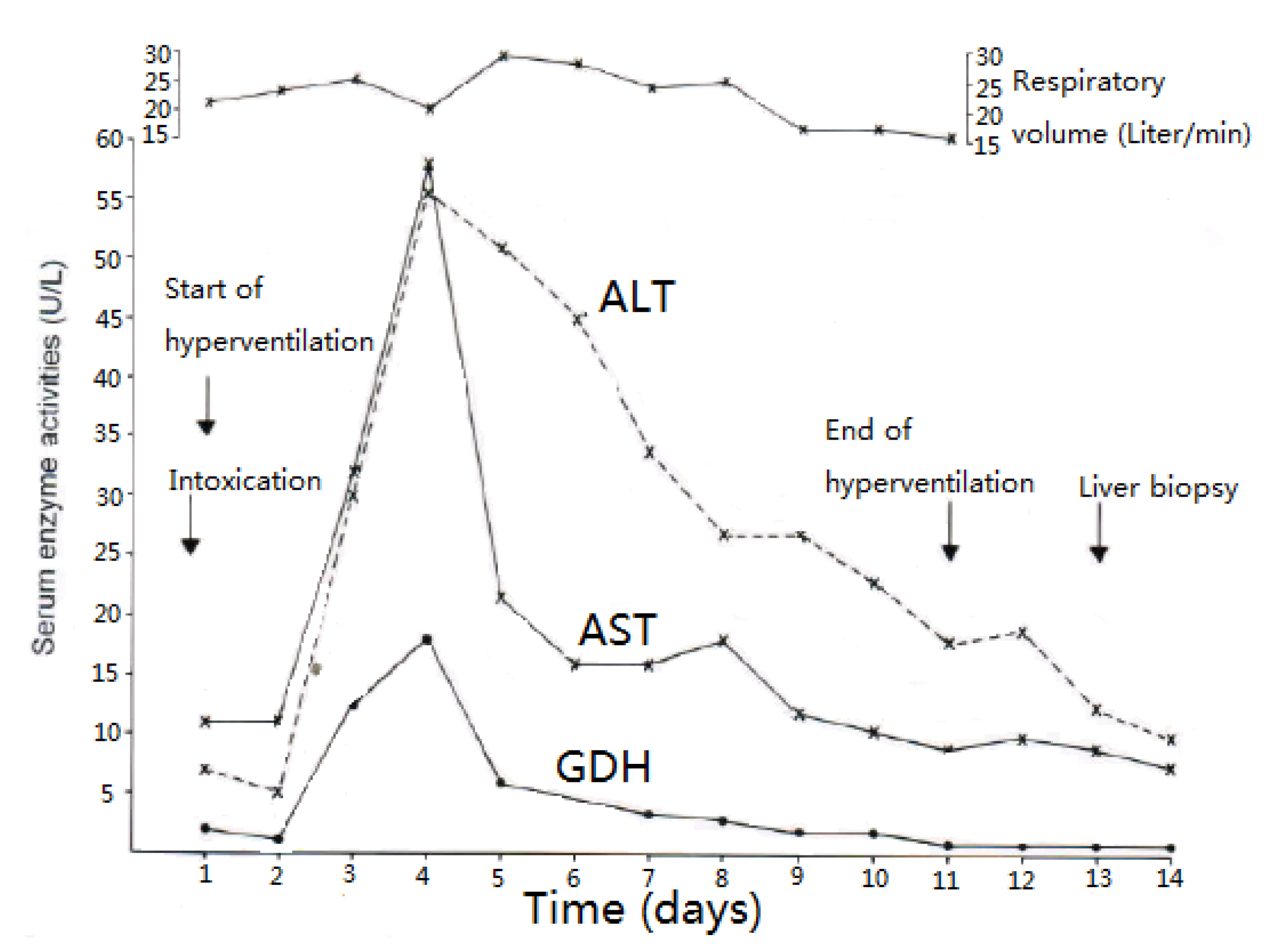
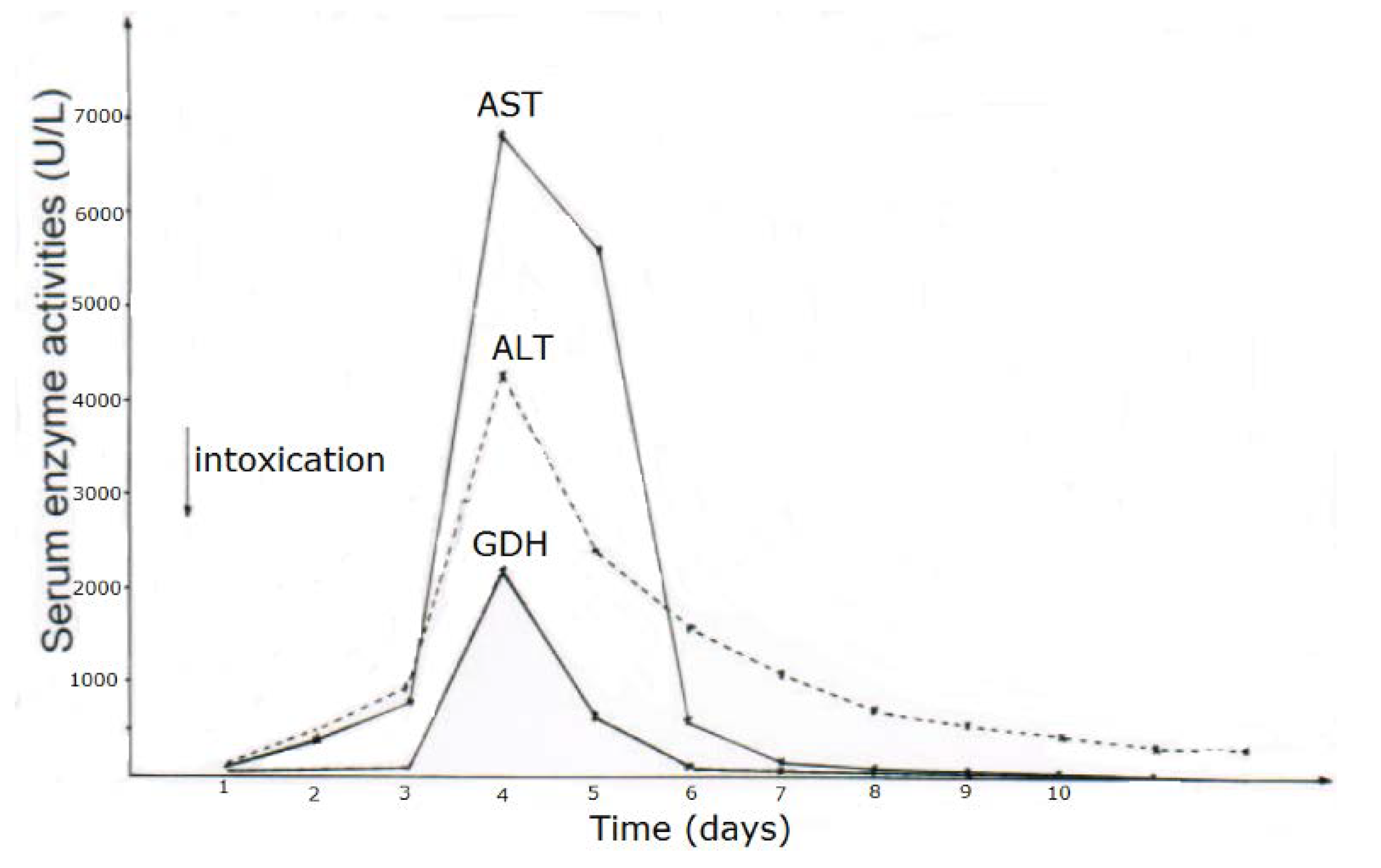

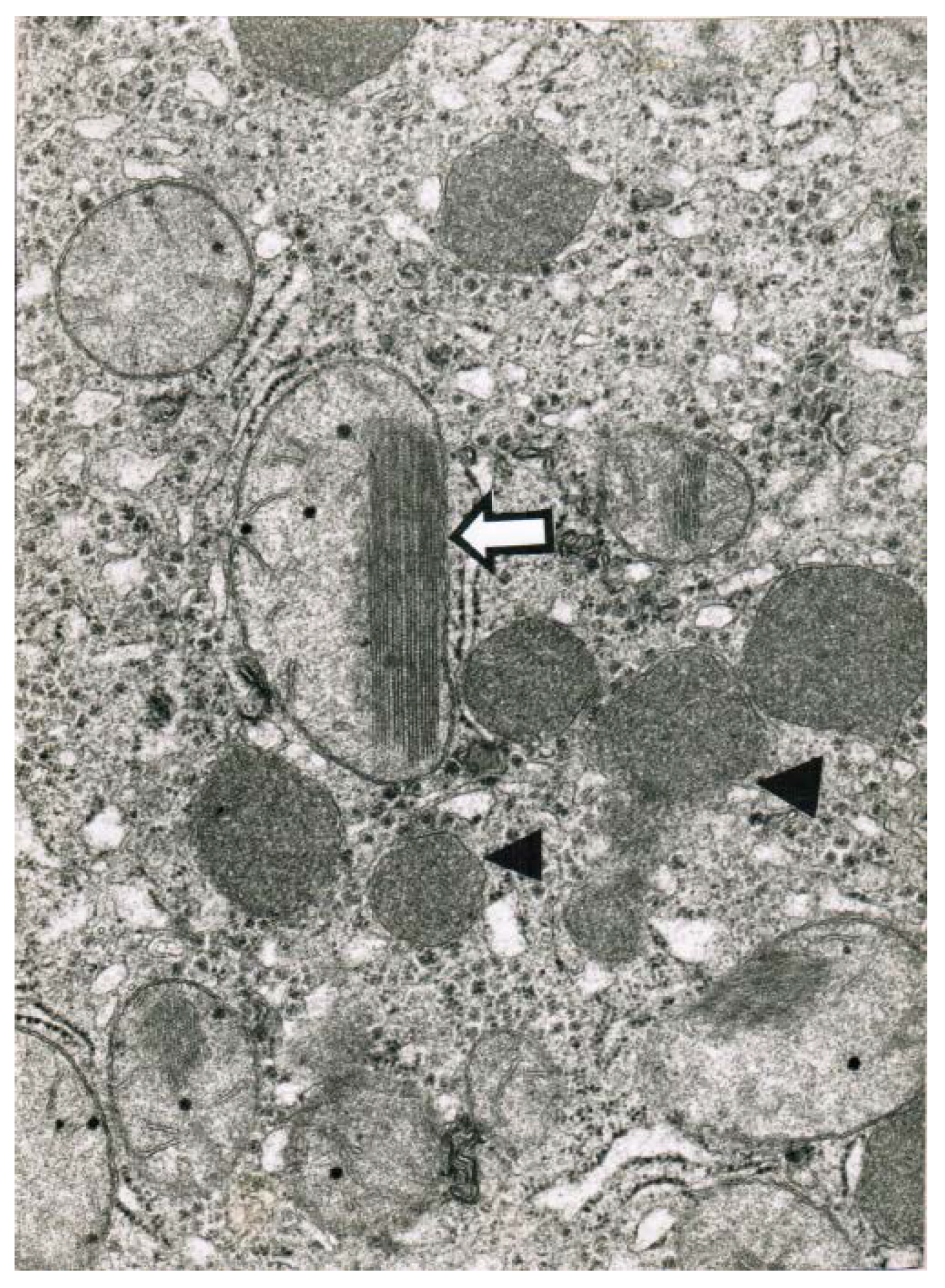
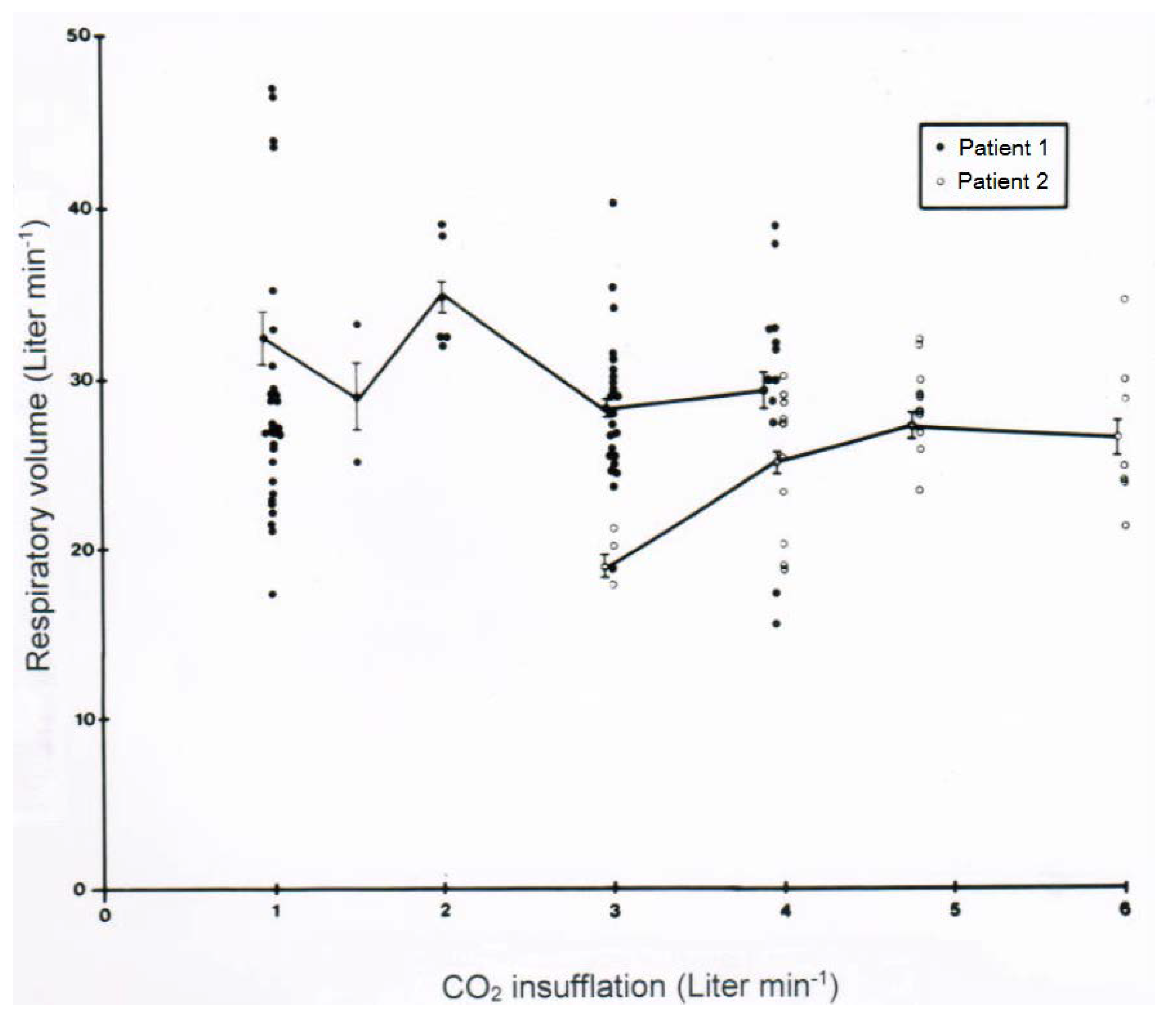
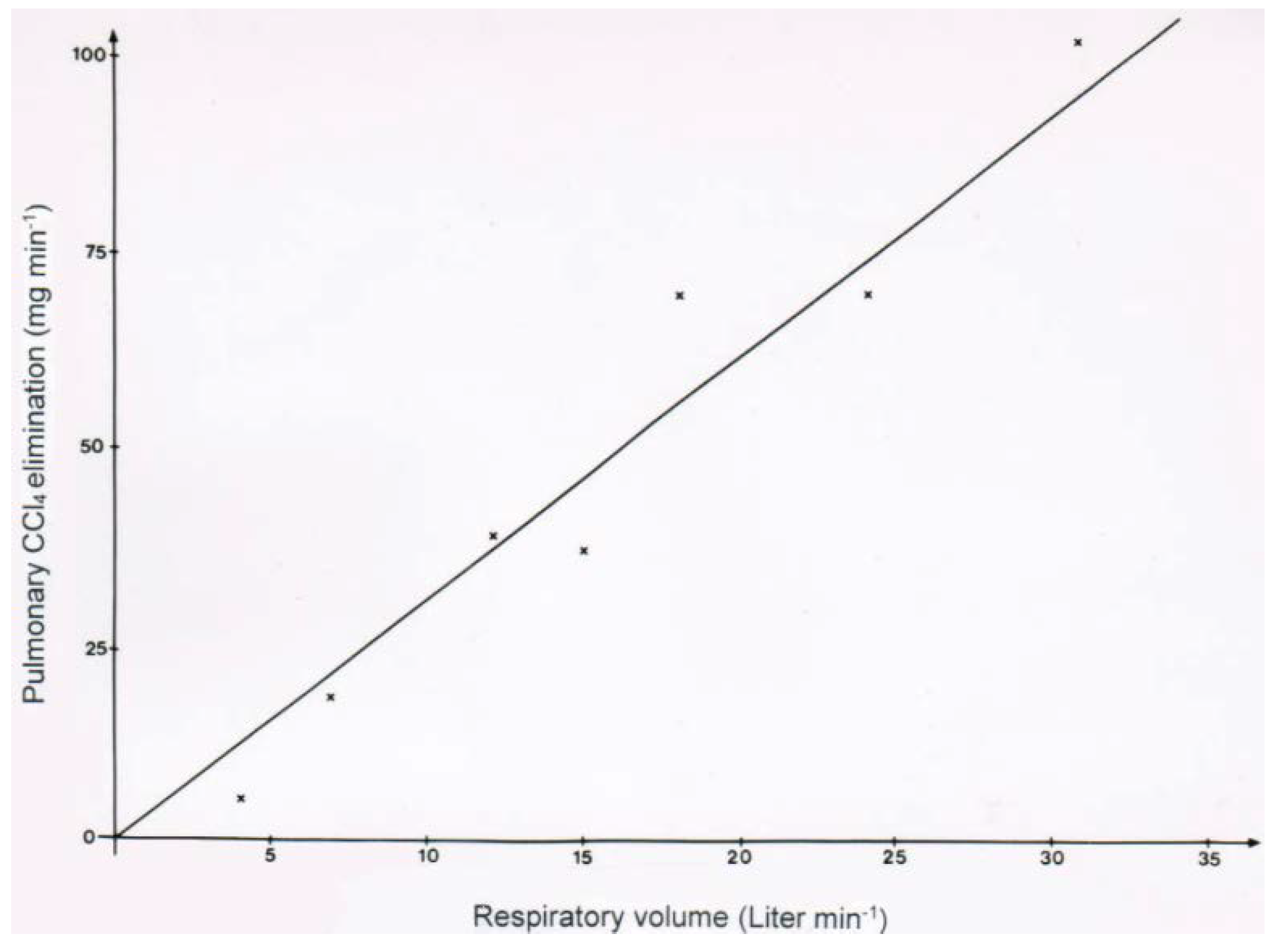

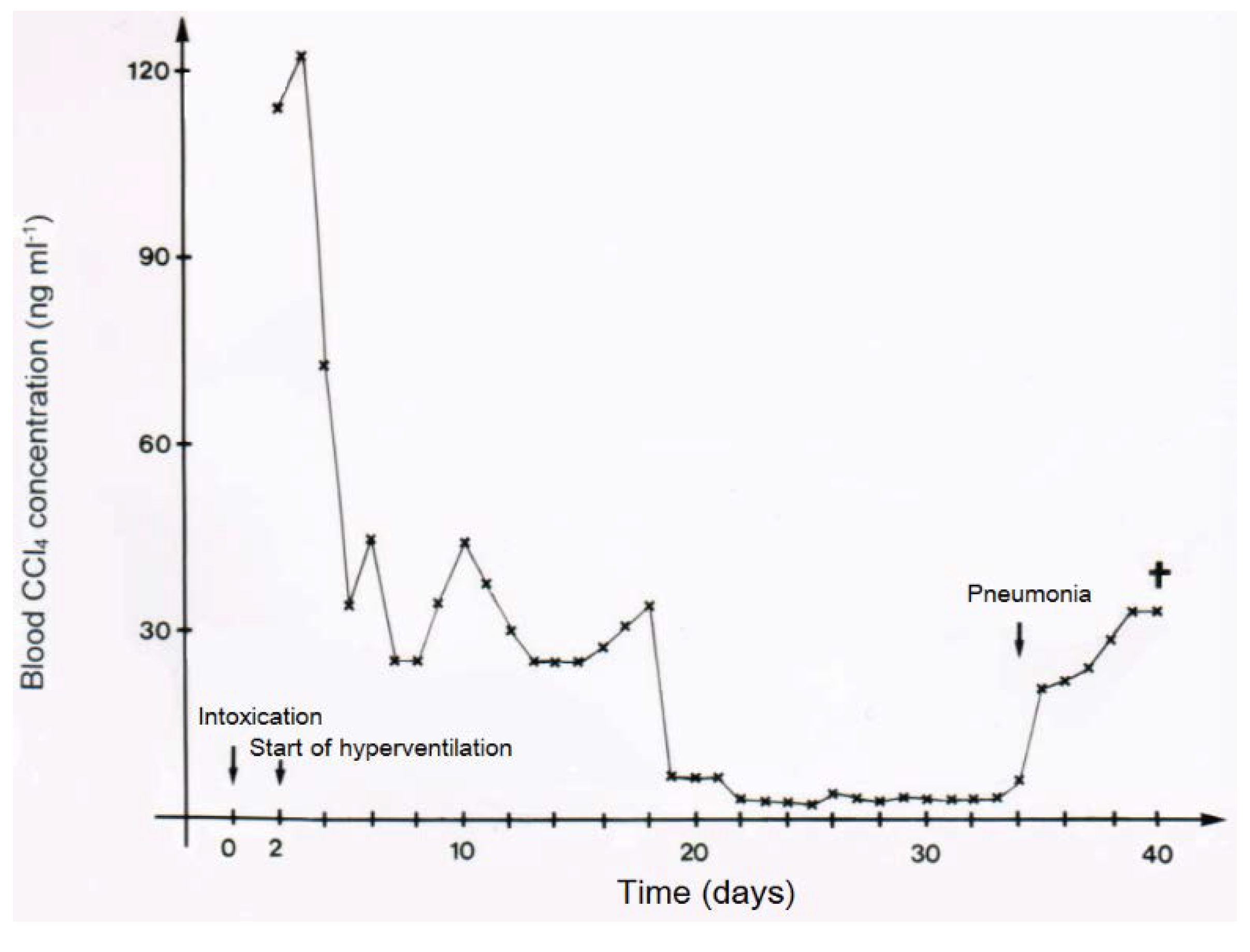
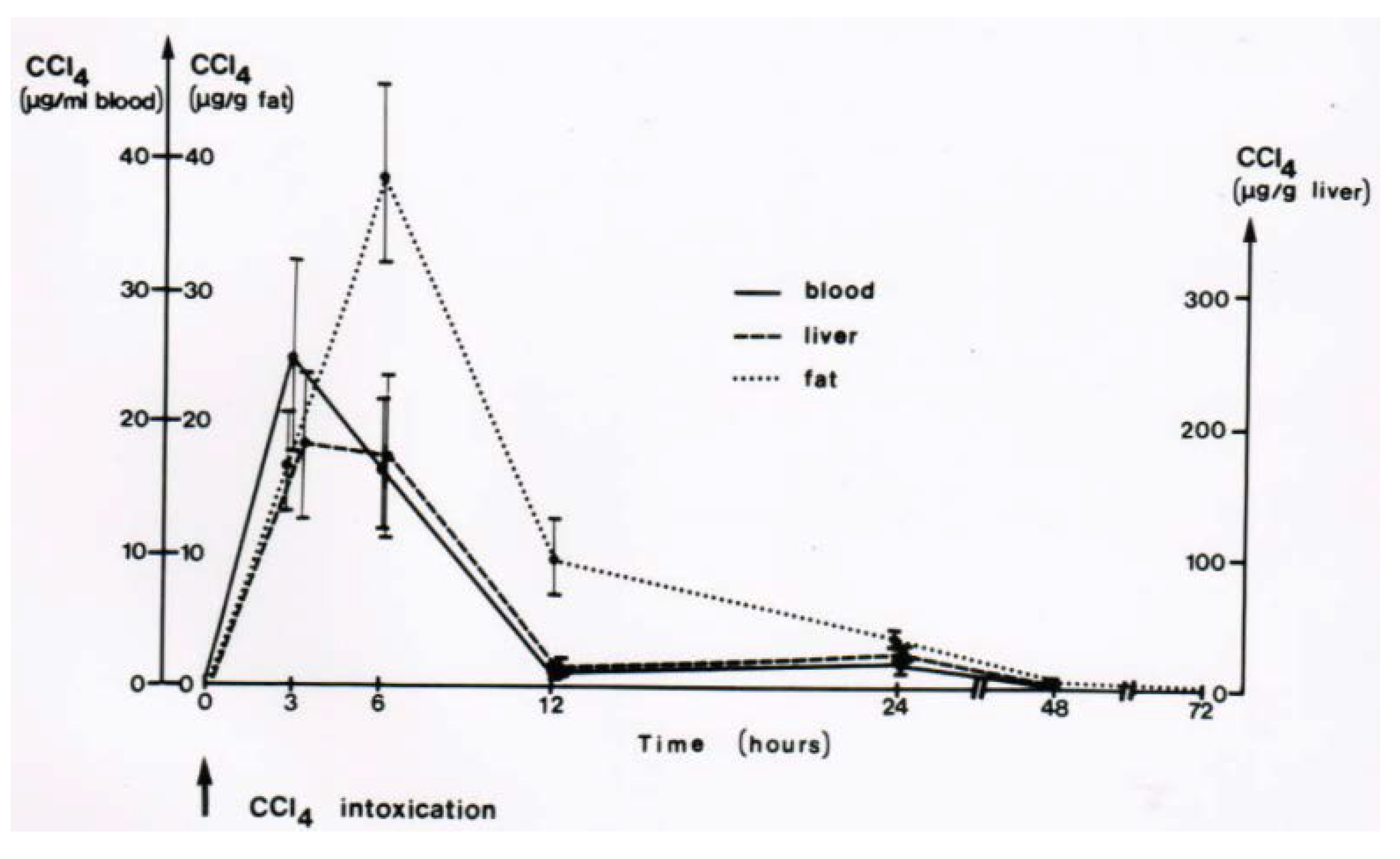
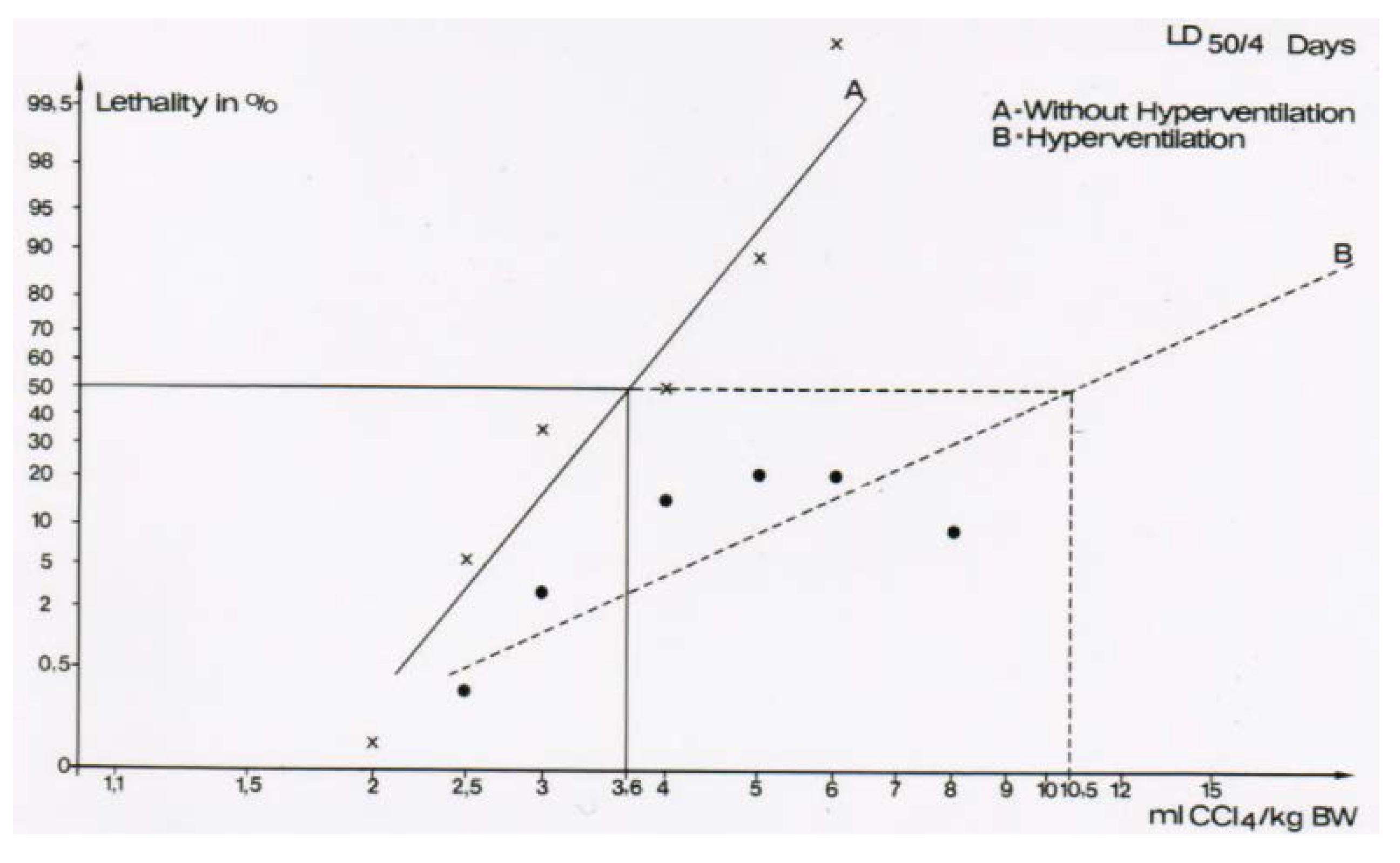
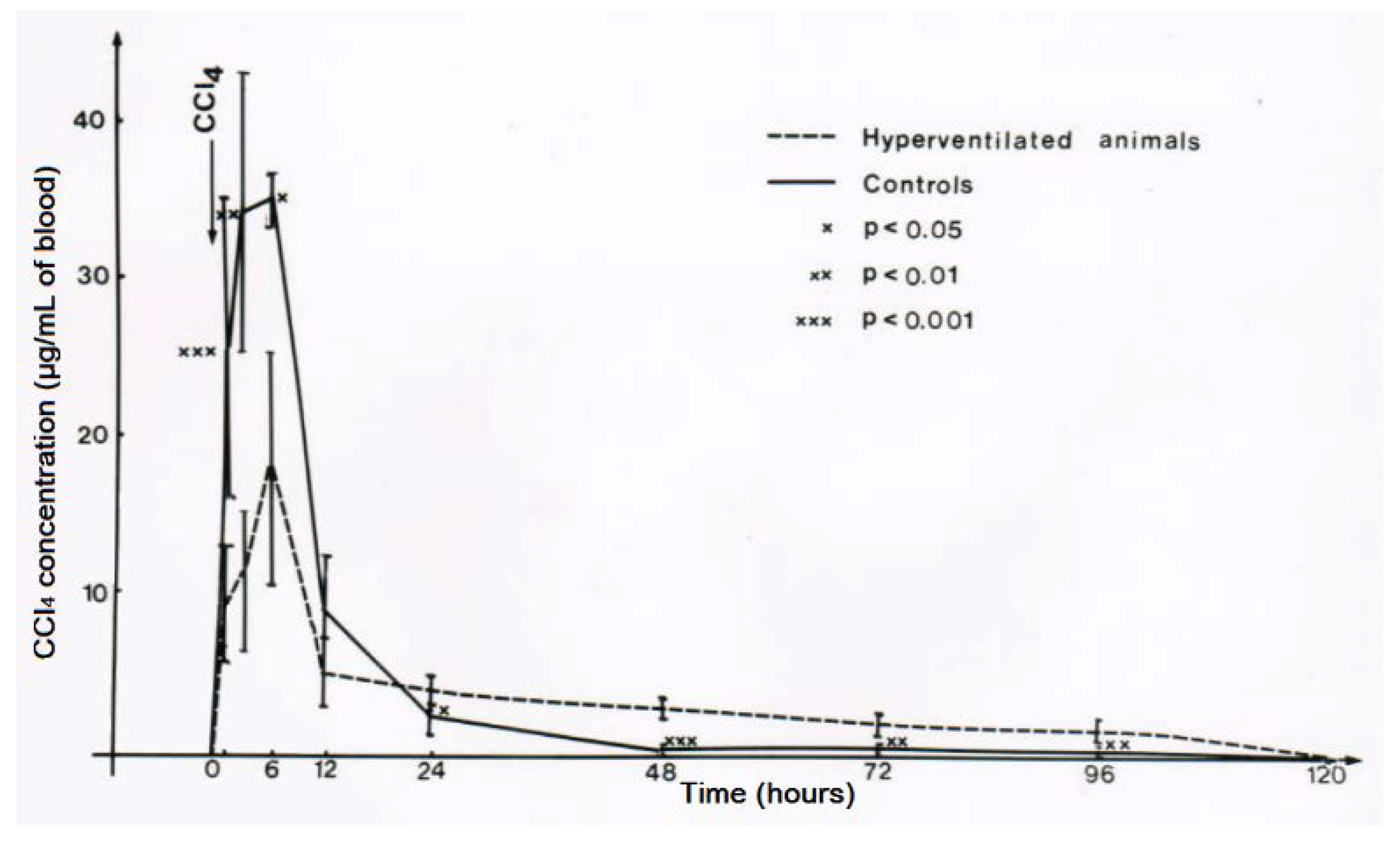
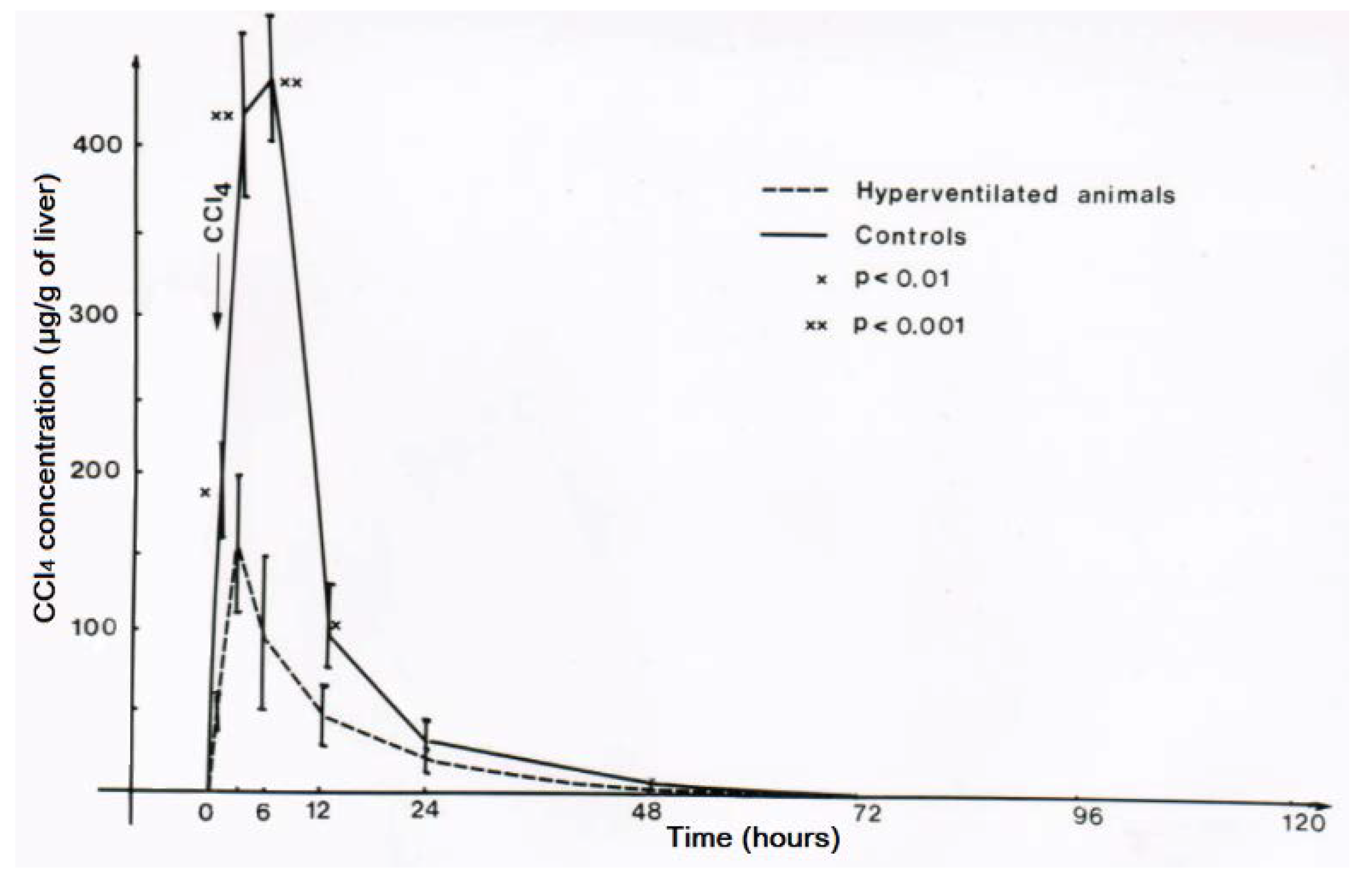


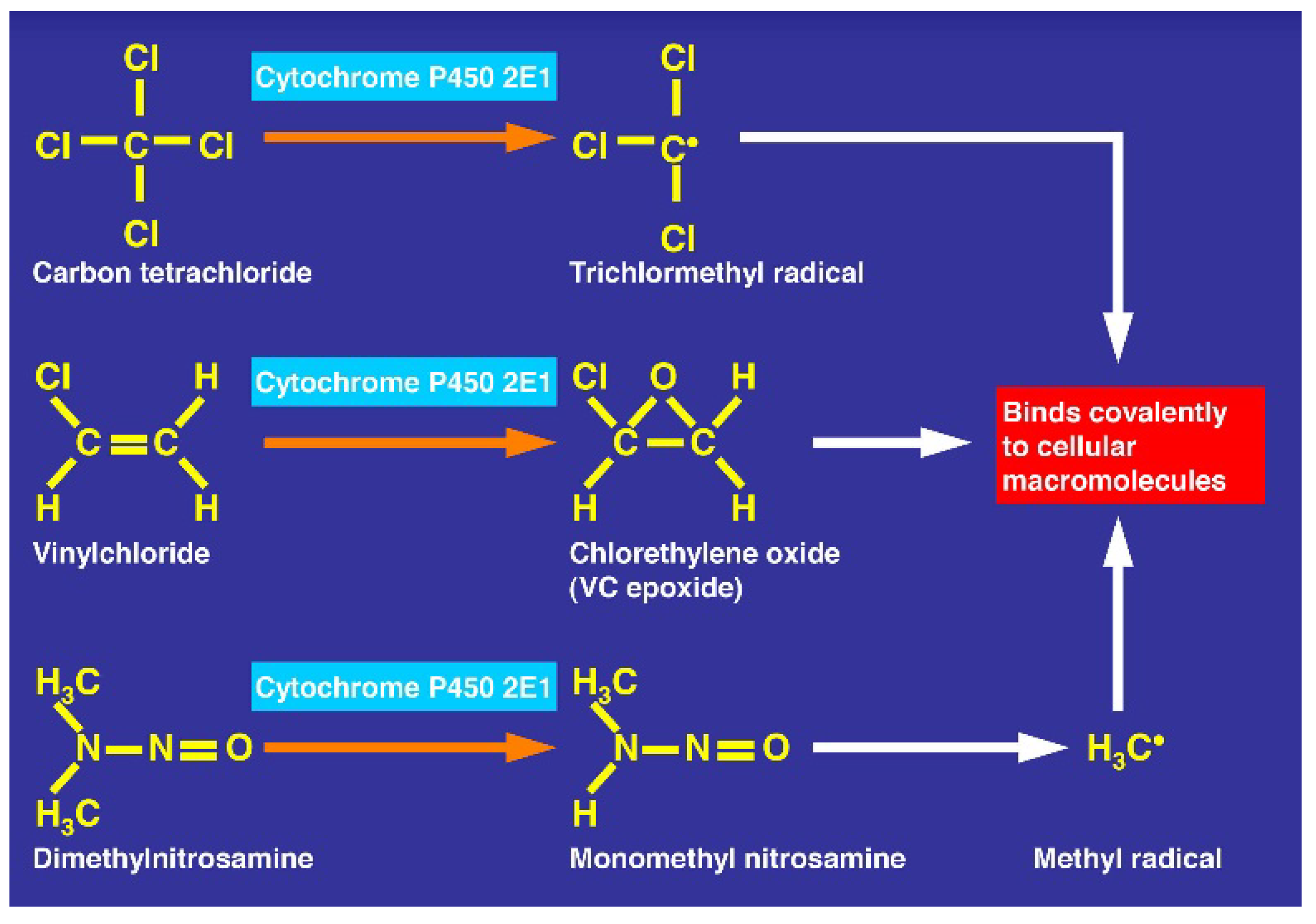
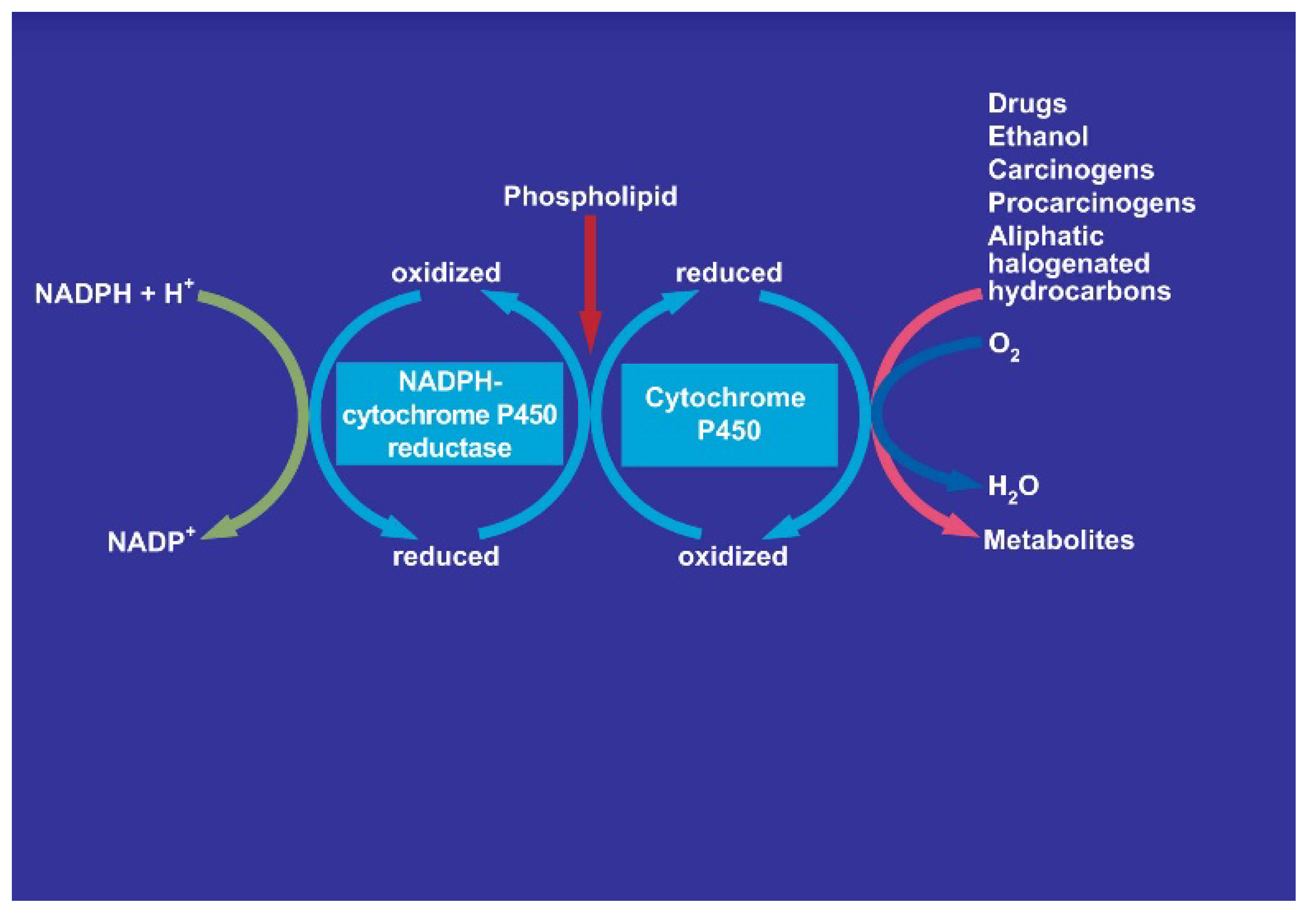

| Year Country | Cases (n) | Case Details | First Author |
|---|---|---|---|
| 1922 Ceylon | 2 | Following ingestion of 13 mL CCl4, liver changes were described as granular degeneration of liver cells with leucocytic infiltration in the first patient, and as fatty degeneration of liver cells with diffuse leucocytic infiltration following 24 mL CCl4 in the second patient. | Docherty [17] |
| 1932 United States | 7 | Author reported having observed 7 men with CCl4 poisoning in a small plant where it was used as a solvent for cleaning. The use of calcium lactate was discussed, as such pretreatment in animals for 1 to 3 weeks prior to poisoning was found to decrease toxicity. | McGuire [18] |
| 1935 United States | 1 | Severe case of accidental poisoning with ingested 118–148 mL CCl4 mistaken as alcoholic beverage in a man addicted to alcohol. Symptoms included vomiting, severe colicky abdominal pains with numerous watery stools, mental cloudiness and confusion. His family physician treated him with gastric lavage. At hospital treatment included a diet high in carbohydrates (200 g) and daily intravenous administration of dextrose and calcium gluconate, associated with oral administration of 1.8 g of calcium lactate and rectal administration of 10% dextrose (120 mL) every four hours. On day 11 so called sino-auricular tachycardia was documented, and on day 62 sinus arrhythmia. Discharge was after 30 days in good condition. | Lehnherr [19] |
| 1950 United States | 12 | Histology data are reported from 12 cases of CCl4 poisonings, 6 from ingestion and 7 from inhalation. All but one of the 12 patients had an acute alcohol problem or chronic alcoholism. Symptoms included nausea, vomiting, abdominal cramps, malaise, and headaches. Jaundice and renal failure were common. Duration of illness was variable, ranging from 2 to 18 days. There was progressive diminution the necrotic areas in the liver with longer periods of survival. Renal changes focused on the proximal convoluted tubules, described initially as swollen epithelial cells and changing later to a more cloudy swelling with marked granularity of the cytoplasm. | Moon [20] |
| 1955 United States | 8 out of 75 | A pathology report of 8 patients who died from acute CCl4 poisoning, derived from 75 cases of fatal CCl4 poisonings on file at the US Armed Forces Institute of Pathology (AFIP). Few patients died from anesthetic effects, most from acute liver or renal failure. Histology findings are detailed described. Liver lesions included confluent zonal necrosis, centrilobular necrosis, and midzonal necrosis. Renal lesions were described as nephrosis, preferentially as fat necrosis. Intoxication was due to inhalation in half of the patients and by ingestion in the other half. Survival after poisoning ranged from 2 to 312 h. Alcohol use was not recorded in one patient, but was associated with CCl4 exposure in 3 patients. In the other patients, alcohol use was classified as occasional or moderate in 2 patients and heavy in the remaining two. | Jennings [21] |
| 1958 United States | 20 | Lethality rate from CCl4 intoxication was 25%, with 5/20 cases. Among the 5 patients with fatal outcome, CCl4 was inhaled by 3 patients and ingested by 2 patients. Among the initial cohort of 20 patients, 16 had consumed large quantities of alcohol daily for a period of months or years, and 14/16 patients took alcohol shortly before, during or shortly after exposure to CCl4. Two patients were not heavy drinkers but had ingested alcohol at the time of CCl4 exposure. | Guild [22] |
| 1962 United States | 11 out of 19 | Report of 19 patients with acute renal failure due to CCl4 intoxication, associated with increased serum activities of AST up to 48,000 U/L in 11 patients. Exposure route in the 19 patients was ingestion in 2 patients and inhalation in the other 17 patients. Alcohol ingestion was described in 17/19 patients, vomiting in all 19 patients, diarrhea in 10/19 patients, and abdominal pain in 13/19 patients. Clinical outcome was favorable in 18/19 patients. | New [23] |
| 1966 Israel | 1 | Patient ingested 20–30 mL CCl4 accidentally, was slightly confuse and showed a maximum of serum AST activity of 182 U/L on day 5. His clinical symptoms subsided the next day. | Fischl [24] |
| 1969 Germany | 8 | CCl4 intoxication was by ingestion in 7 patients and by inhalation by one patient. Ingested CCl4 ranged from 8 mL to 150 mL. In 7/8 patients renal insuffiency was detected that required dialysis in 6 of these. Most patients had symptoms of gastroenteritis, partially with bleeding. Maximum total bilirubin was 19.5 mg/dL and maximum serum ALT activity was 2396 U/L. Liver histology was unremarkable in in 3 out of 4 patients, whereas in another patient a questionable steatosis and remnants of liver cell necroses were detected 12 weeks after intoxication. Toxic pancreatitis was diagnosed in 3/8 patients. Two patients died from cardiac failure. Overall lethality rate was 2/8 patients equivalent to 25%. | Dume [25] |
| 1972 United Kingdom | 1 | Intoxication by intentionally ingestion of 120 mL CCl4 together with Na-phenobarbital, Carbromal, trichloral, and ethanol. He complained of a burning sensation in his abdomen and throat. Vomiting was not reported, but stomach washout was initiated 2–3 h after ingestion. Maximum serum activities of AST (6700 U/L) and AST (10,700 U/L) were reported on day 4 following ingestion were reported. Maximum serum creatinine (9 mg/dL) was described on day 7, and initially decreased urinary output was successfully treated including also the use of furosemide. Atrial fibrillation commenced on day 4 with a pulse rate of 120–140/min and spontaneous reversal to sinus rhythm on day 22. Hemoglobin fell from 17.5 to 10.2 g/dL. Recovery was complete at discharge on day 29. | Kennaugh [26] |
| 1981 Kuwait | 1 | Inhalation of CCl4 during cleaning machinery on a ship led to hospital admission 10 days after inhalation, when serum activity of AST was 71 U/L and of ALT 90 U/L, with normalization in the further course. Patient experienced myocarditis and required artificial ventilation and dialysis during his 14-day hospital stay. | Hadi [27] |
| 1982 Germany | 3 | The 3 male patients consumed 2–5 bottles of beer and ingested unintentionally 1–2 swallows (around 20–40 mL) from a bottle containing 20% CCl4. Among the symptoms were headaches, vomiting, abdominal pains, and diarrhea in all patients. Dialysis was required in 2/8 patients. Maximum serum ALT activity of was 5500 U/L. Clinical course was otherwise uneventful. | Schäfer [28] |
| 1982 United States | 1 | Intentional poisoning by ingestion of 250 mL CCl4, patient was found in a semicomatose condition and experienced profuse watery diarrhea. Vomiting was not reported. Following 4 h, he was admitted to the hospital. Blood alcohol level was 0.5 mg/dL. A carbon monoxide intoxication was initially suspected due to an erroneously high blood CO level that was later corrected to 4.3 Vol %, and the patient was treated with hyperbaric oxygen at 2.5 atm for 45 min. Hyperbaric oxygen therapy was reinstituted on day 5 and provided until day 16 with 2.0 atm for 2 h twice daily. Maximum serum activities of AST were around 420 U/L on day 5 and of ALT around 700 U/L between days 6 and 7. Additional treatments started 16 h after ingestion and included charcoal, mineral oil laxatives and hypothermia using a cooling blanket. As a diagnostic aid, X-ray of the abdomen revealed radiopaque material in the small bowel and colon, considered to be CCl4. Outcome was favorable. | Truss [29] |
| 1983 Canada | 1 | Patient ingested intentionally 100 mL CCl4 and rum, experienced severe liver injury with maximum serum ALT activity of 10,000 U/L on day 2 and renal failure with maximum serum creatinine of 13.8 mg/dL on day 7 requiring hemodialysis. Treatment included also parenteral nutrition. Patient survived. | Fogel [30] |
| 1985 United Kingdom | 19 | Acute CCl4 poisoning in 19 patients with blood CCl4 levels ranging from 0.1–31.5 mg/L. Vomiting (11 patients), abdominal pain (5), diarrhea (4), and coma/drowsiness (6) were the most common symptoms and signs. Maximum serum activities of AST was 8070 U/L and of ALT 8600 U/L. Out of 13 patients treated with intravenous N-acetylcysteine, 7 patients showed mild hepatic damage, 1 patient had moderate hepatic damage, and 1 patient with a history of alcoholism sustained massive hepatorenal damage and needed hemodialysis. Of the 6 patients (1 lost to follow-up) who were not given N-acetylcysteine 3 patients had hepatorenal failure and needed dialysis, and 1 patient died. Prompt treatment with N-acetylcysteine was considered to minimize subsequent hepatorenal damage. | Ruprah [31] |
| 1994 Japan | 1 | Patient with a history of chronic alcohol use ingested CCl4 and complained about nausea, vomiting, abdominal pain, and diarrhea. Maximum activity of serum AST was 5160 U/L and of ALT 3000 U/L. Liver histology showed perivenular and centrilobular fibrosis and preferentially in the centrilobular area also liver cell necrosis, ballooned hepatocytes, cellular infiltration and fat droplets. Histology findings likely represent a combination of alcohol use and CCl4 ingestion. | Hoshino [32] |
| 2013 Slovakia | 60 | CCl4 intoxication in 60 patients, lethality rate of 3.3%. No case details were provided in the report. | Mydlík [33] |
| Points of Clinical Interest |
|---|
| Starting from 1922, data from historical reports in humans provide the following facts: ● The historical use of CCl4 as anthelmintic chemical is obsolete and was early recognized ● CCl4 is hepatotoxic and nephrotoxic, toxicities may occur one after the other, together, or alone in a patient, but risk factors that determine the sequence of injurious events are unknown ● Most poisonings occur by ingestion or inhalation ●The degree of cellular toxicity in liver and kidney is independent from the route of toxin uptake ● A close dose dependency of liver injury by CCl4 is not apparent in the reported inhomogeneous cohorts ● A lethal dose of CCl4 cannot be established with certainty due to many confounding variables of toxin uptake ● Vomiting is a frequent early symptom after CCl4 inhalation or ingestion, facilitating toxin removal ● Profuse diarrhea helps accelerating toxin removal after CCl4 ingestion ● Alcohol use is commonly described, preexisting as chronic abuse or acutely at occasion of CCl4 poisoning ● Several methods for primary toxin removal from the gastro-intestinal tract have been used, including gastric lavage, using charcoal or paraffin, but sufficient evidence of efficacy was not provided ● Under the assumption of potential benefit, several compounds have been administered, such as iron ● Little new evidence was provided of attempting to remove more effectively the toxin ● Effective liver transplantation in acute liver failure by CCl4 has not been reported ● Patients who survived an acute CCl4 intoxication commonly have a good prognosis without permanent injury but results of stringent follow-up studies were not published ● Lethality rates of acute CCl4 intoxication were found in a broad range from 2% up to 25% ● Specific causes of death were rarely reported but most were likely due to hepatic or renal injury ● No attempt was made to introduce drugs for inhibition the microsomal metabolism of CCl4 to toxic metabolites ● Liquemin use was not addressed ● Clinical cohorts lacking homogeneity ● A biphasic clinical course with a free interval was early recognized ● X-ray abdomen to detect possible radiopaque material of the small bowel and colon as sign of suspected CCl4 ● Early descriptions of cardiac arrhythmias, anemia, and anuria |
| Diagnostic Criteria |
|---|
| 1. History of poison administration 2. Details on route of CCl4 uptake 3. Assessing uptake of CCl4 amount and vomiting to estimate uptake of total dose 4. Initial symptoms may rarely include narcosis 5. Assessment of alcohol use prior to intoxication and at time of poisoning to estimate extra risk of ethanol for liver injury by CCl4 6. X-ray abdomen that may show opaque changes in the intestinal tract suggestive of intraluminal CCl4. 7. Qualitative and semi-quantitative analysis of CCl4 in the exhalation air using the Draeger-tube® system (DTS) 8. Quantitative analysis of CCl4 in the blood using the heads-space technique of gas chromatography 9. Routine laboratory evaluation as commonly done in a setting of an intensive care unit 10. Special care is needed to early recognize respiratory insufficiency, alcohol withdrawal symptoms, renal insufficiency acute renal failure, liver function disturbances and acute liver failure, cardiac arrhythmias, anemia, toxic bone marrow injury, disseminated intravascular coagulation (DIC), blood glucose in face of high glucose administration. |
| Therapy Approaches | Ingestion | Inhalation |
|---|---|---|
| 1. Endotracheal intubation prior to intended gastro-intestinal lavage after evaluation for risk of aspiration | + | - |
| 2. Primary toxin elimination by gastro-intestinal lavage in the intubated patient. Endoscopic removal of the ingested hydrocarbon from the stomach is not recommended, because the toxin by virtue of its strong solvent property may damage parts of the gastroscope. For activated charcoal and paraffin, no evidence for clinical efficacy in CCl4 poisoning exists | + | - |
| 3. Forced ventilation by CO2-induced hyperventilation therapy aims to accelerate toxin removal by exhalation and should be maintained until abnormal laboratory tests such as liver and kidney parameters approach normal values | + | + |
| 4. Central venous access | + | + |
| 5. Intravenous cimetidine as bolus (200 mg) for inhibition of CCl4 degradation by CYP, then 1600 mg for the initial 24 h via infusion pump and for the subsequent days | + | + |
| 6. Intravenous 400 g glucose/24 h and on subsequent days to down-regulate CYP to reduce CCl4 degradation | + | + |
| 7. Intravenous electrolytes plus furosemide aiming forced diuresis to prevent renal failure | + | + |
| 8. Liquemin 15,000 IU/24 h and on subsequent days to minimize the risk disseminated intravascular coagulation (DIC) | + | + |
| CO2-Induced Hyperventilation in Adults |
|---|
| Aim of therapy |
| Forced CO2-induced hyperventilation is also called CO2-induced hyperventilation therapy to specifically indicate its therapy goal. It aims to increase pulmonary excretion of CCl4, ideally in an adult or adolescent patient lacking respiratory insufficiency. |
| Sufficient spontaneous respiration |
| Therapy should be started right after gastro-intestinal lavage has been completed and when endotracheal intubation is not any more needed. Forced hyperventilation is inaugurated by CO2, applied to the patient in a sitting bed position. CO2 must be of pure quality and suitable for human use, commonly supplied in gas cylinders, safely placed nearby the bed and the head of the patient. The patient inhales the CO2 after passing through a humidifier, a sealed tube, known as nasal oxygen tube. Concomitantly, the patient inspires usual air by open mouth and alternately expires the contaminated air by mouth. CO2 is applied at a flow rate of 2–3 L per minute, and with regular inspiration via the nasal tube, an increased respiratory minute volume of up to 25–30 L should be achieved [8]. If the nasal tube is not tolerated, it can be replaced by CO2 application through a common, not tightly placed oxygen mask, but this approach is less effective and associated with the risk of again inhaling the contaminated exhalation mixture. Alternatively, a modern viable oxygen mask may perhaps be used with valves inside of these tight-fitting masks may be used that control the flow of gases into and out of the masks, so that rebreathing of exhaled gas is minimized. However, experience with such modern masks is not yet available in the context of CO2-induced hyperventilation. |
| Insufficient spontaneous respiration |
| Patients with respiratory insufficiency require endotracheal intubation for artificial respiration device, using for instance a Bird-system; CO2 at a flow rate of 2–3 L per minute is then added to the respiratory mixture to achieve hyperventilation. This is a critical clinical situation for which decisions are required on a case by case basis. In general, patients with a preexisting chronic obstructive pulmonary disease should not be candidates for a CO2-induced hyperventilation therapy due to the unfavorable benefit versus risk constellation. As this therapy is not without risks, skilled physicians preferentially pulmonologists should take care for these patients in a setting of an intensive care unit. The therapy requires a 24 h surveillance of the patient with regular measurements of the respiratory minute volume as well as blood gas analyses in order to early recognize complications. Needless to say, constant room ventilation is required to remove the exhaled toxin. |
| Patients | pO2 (mmHg) | pCO2 (mmHg) | pH | CHO3− (mval/L) |
|---|---|---|---|---|
| Normal range | 81–99 | 25–45 | 7.36–7.44 | 22–26 |
| Patient 1 | 100 ± 11 | 49 ± 1 | 7.37 ± 0.01 | 26 ± 2 |
| Patient 2 | 103 ± 4 | 45 ± 3 | 7.41 ± 0.01 | 27 ± 1 |
| Patient 3 | 95 ± 2 | 50 ± 3 | 7.33 ± 0.03 | 23 ± 1 |
| Patient 4 | 84 ± 16 | 42 ± 3 | 7.47 ± 0.02 | 29 ± 1 |
| Patient 5 | 87 ± 5 | 41 ± 2 | 7.40 ± 0.02 | 24 ± 1 |
| Case | Intoxication | Case Details |
|---|---|---|
| 1. Male 15 years | Carbon tetrachloride Ingestion (30 mL) | Patient swallowed intentionally 30 mL CCl4 and experienced twice vomiting before he was treated in a regional hospital by gastro-intestinal lavage. At admission in our intensive care unit 9 h after intoxication, he was mentally conscious and CCl4 was detected in the expiration air presently and during the next 4 days, as analyzed by the Draeger-tube® system (DTS). CO2-induced hyperventilation was started and continued for 11 days. CO2 was applied via a nasal tube at a flow rate of 2–4 L/min and resulted in a respiratory volume of up to 30 L/min. On day 3 after intoxication, Serum activities of liver enzymes increased and reached a maximum on day 4 (AST 59 U/L, ALT 56 U/L, GDH 18 U/L) and normalized during the next days until day 14 after intoxication. Liver biopsy on day 13 showed no abnormalities. Patient was discharged on day 15. |
| 2. Female 14 years | Carbon tetrachloride Ingestion (10–20 mL) | Patient ingested intentionally 10–20 mL CCl4 accessed to from a dry cleaning business where her mother was employed. She was initially admitted to a regional hospital 1.5 h after ingestion where a solvent exhalation smell was realized of the fully oriented patient. A gastro-intestinal lavage was initiated and paraffin was given before she was transferred to our intensive care unit using an emergency car with a doctor. During the transfer she vomited several times and wet herself. At admission 7 h after ingestion, CCl4 was 10 and 20 ppm as analyzed by DTS, she was fully oriented and received a CO2-induced hyperventilation therapy for 4 days. CO2 was given via a nose tube at a flow rate between 2 and 5 L/min, which resulted in a respiratory rate ranging from 24/min to 42/min, associated with a respiratory volume between 21.5 and 33.2 L/min. arterial PO2 was in a range of 94–98%, arterial pH was between 7.26 and 7.39, and CHO3− between 22.1 and 25.5 mval/L. ECG was always unremarkable. During treatment, creatinine and total bilirubin were always normal, INR was 1.5. At admission, liver tests were within the normal range and marginally increased on day 4 for AST (42 U/L) and ALT (33 U/L). Liver histology by hematoxylin and eosin staining 4 days after termination of the CO2-induced hyperventilation therapy showed no overt liver cell necrosis but severe micro-vesicular fatty liver in 80–90% of the liver cells. With a body weight of 48.6 kg, a height of 1.67 m, and a resulting BMI of 17.4 kg/m2, pre-existing nonalcoholic fatty liver disease was unlikely. By electron microscopy, cristae of mitochondria are reduced and disorganized. Within the mitochondria crystalline inclusion bodies are found. A few mitochondria represent mega-mitochondria. Abundant lysosomes are found. Discharge was 10 days after ingestion, all laboratory values were in the normal range at that time. |
| 3. Male 31 years | Carbon tetrachloride Ingestion (50 mL) | Patient intentionally swallowed 50 mL CCl4 and was found by his mother. After initial treatment in a local hospital and recurrent vomiting, he was admitted at our intensive care unit the same day, where he received a gastro-intestinal lavage and was started on the usual CO2-induced hyperventilation therapy for 6 days, achieved with CO2 3–5 L/min. CCl4 was detected in the expiration air using the DTS and confirmed in the blood by GC. Clinical course was uneventful, except for a short increase of AST (66–70 U/L) and ALT (123–170 U/L) during day 3 to 5 after ingestion. Patient was discharged 3 days after termination of the hyperventilation. |
| 4. Male 70 years | Carbon tetrachloride Ingestion (~50 mL) | Patient ingested unintentionally ~50 mL CCl4 contained in a bottle labelled erroneously as lemonade. Within 30 min thereafter, he experienced diarrhea with black-colored stools, later also recurrent vomiting. At admission in a local hospital he was sleepy and was transferred the same day to our intensive care unit for gastro-intestinal lavage and CO2-induduced hyperventilation for 8 days. Presence of CCl4 in the blood was confirmed by GC at several occasions. Peak serum activities for AST (92 U/L) and ALT (215 U/L) were observed on day 7 after ingestion. After termination of the hyperventilation therapy, the patient was re-transferred to his local hospital. |
| 5. Male 40 years | Carbon tetrachloride Ingestion (100 mL) | Patient intentionally swallowed 100 mL CCl4, was initially treated in a local hospital with gastrointestinal lavage and endotracheal intubation for initiating CO2-induced hyperventilation also during transport via plane to our intensive care unit at the same day. At arrival, CCl4 was detected in the expiration air using the DTS, and after extubation the hyperventilation therapy was continued with CO2 up to 4 L/min via nasal tube for overall 10 days, resulting in a minute respiration rate of 25–30 L/min. The patient was somnolent during several days, an unusual clinical observation. Maximum values for serum activities of AST (5735 U/L) and ALT (3821 U/L) were observed on day 4 after ingestion, which was associated with a maximum increase of serum creatinine (2.1 mg/dL). Liver histology by hematoxylin and eosin stain on day 14 after ingestion revealed moderate centrilobular micro-vesicular fatty liver with few liver cell necrosis. Electron microscopy with 5200-fold magnification showed a striking proliferation and pronounced dilatation of the smooth endoplasmic reticulum of the hepatocyte, presenting as dilated cisterns. Few mitochondria are enlarged and most mitochondria are injured. Abnormal laboratory results returned to normal values rapidly, and the patient was discharged 14 days after ingestion. |
| 6. Male 16 years | Carbon tetrachloride Ingestion (~30 mL) | Patient ingested intentionally CCl4 (~30 mL) and was admitted to a local hospital for gastro-intestinal lavage. Documented are recurrent vomiting, nausea and dizziness. On the day of ingestion, the fully oriented patient was transferred to our intensive care unit for CO2-induced hyperventilation, done for 10 days with CO2 (3–5 L/min), which resulted in a respiratory frequency of 28–36/min and a respiratory minute volume of 21–28 L/min. On day 5 after ingestion, peak values were determined for AST (59 U/L) and for ALT (56 U/L), which rapidly normalized within few days. Liver histology 13 days after ingestion showed minimum steatosis in a few liver cells and single liver cell necrosis. Discharge was on day 14 after ingestion. |
| 7. Female 50 years | Carbon tetrachloride Inhalation (~ 10 mL) | Patient inhaled unintentionally CCl4 (~10 mL), which she used for cleaning of a spot on her carpet. She experienced nausea that persisted for 1 day until she approached a local hospital, which arranged the transfer to our intensive care unit for initiating CO2-induced hyperventilation therapy, which was accomplished in the usual way by nasal tube. Here CCl4 was not detectable in the expiration air through the DTS, but in the blood ethanol was detected with 1.77‰. The hyperventilation therapy was applied for 3 days, Initial serum activities of AST (16 U/L) and ALT (20 U/L) remained virtually unchanged during the following days, ranging from 8 to 20 U/L. Discharge was on day 4 after intoxication. |
| 8. Female 50 years | Carbon tetrachloride Ingestion (~50 mL) | Patient unintentionally took one swallow of CCl4 contained in a mineral water bottle, vomited intentionally and drank 0.5 L milk thereafter. During the following hours at home, she suffered from severe headaches and nausea before she arranged admission to a local hospital the next day. After transfer to our intensive care unit, CCl4 was detected in the expiration air by the DTS, and the patient received the usual CO2-inducded hyperventilation therapy, requiring CO2 (2–3 L/min) to achieve a respiratory frequency of 24–30/min. After 5 days, the therapy was terminated. Peak enzyme activities were determined for serum AST (1600 U/L) and ALT (2560 U/L) 4 days after ingestion, with retarded decline and normalization during the following days. Liver biopsy was not done. Discharge from our hospital was 9 days after ingestion. |
| 9. Male 36 years | Carbon tetrachloride Ingestion (50 mL) | Patient intentionally ingested 50 mL CCl4. At the same time, he consumed beer (~2.5 L) and hard liquor (~0.5 L), vomiting in the further course was negated. For many years before, he drank 1–2 L beer daily but no hard liquors. At admission to the local hospital 5 h after CCl4 ingestion, his blood ethanol was 2.5–3.0‰. Gastro-intestinal lavage was initiated and transfer to our intensive care unit was organized where he arrived 6.5 h after CCl4 ingestion. At admission, presence of CCl4 in the blood was confirmed by head-space GC. Serum liver tests were all in the normal range: AST (10 U/L), ALT (14 U/L), and GGT (9 U/L), associated with marginally increased serum total bilirubin (1.5 mg/dL) and normal serum creatinine (0.9 mg/dL). Hyperventilation was initiated with CO2, initially with 2 L/min and intermittently with up to 4 L/min via nasal tube. Respiratory volume commonly was 15–33 L/min and respiratory frequency 15–28/min. On day 3 after CCl4 ingestion, a peak was observed for AST (8960 U/L) and AST (4200 U/L), with a subsequent decline. Total bilirubin was elevated with 1.5 mg/dL on the day after ingestion and increased steadily up to 18.9 mg/dL (with 15.8 mg/dL direct bilirubin) on day 24, followed by subsequent decline. Serum creatinine started with 1.4 mg/dL on day 2 after ingestion to increase and reached values of up to 19.7 mg/dL on day 35. Endotracheal intubation was required on day 6, and dialysis was started on day 18 following CCl4 ingestion. The further clinical course was complicated by 2 reanimations, acute liver failure and a pneumonia that developed on day 34 following CCl4 ingestion and was not treatable with antibiotics. Along the treatment, blood CCl4 levels as determined by head space GC were high at beginning, and much lower in the further course. The cause of death was classified as respiratory insufficiency along with multi-organ failure, related to acute CCl4 intoxication with excessive alcohol use as risk factor. |
| 10. Female 22 years | Carbon tetrachloride Inhalation (~50 mL) | Patient inhaled intentionally CCl4 (~50 mL) and remained at home. Next day she noticed some nausea, and the other day she experienced increasing symptoms of nausea and stomach cramps. Following presentation at a local hospital she was transferred to our intensive care unit for CO2-induced hyperventilation. At admission, she was alert and had tachycardia with a pulse rate of 120/min but in the further course she was intermittently somnolent. By head space GC CCl4 was not detectable in the blood. CO2-induced hyperventilation via nose tube was initiated and performed for 11 days. Maximum increases were found for serum activities of AST (6770 U/L) and ALT (7990 U/L), but subsequent decline was prompt. At discharge on day 11 after intoxication she was in good condition, AST was 43 U/L and ALT 271 U/L. |
| 11. Male 33 years | Carbon tetrachloride Inhalation (unknown amount) | Patient unintentionally inhaled CCl4 for several days, classified as occupational intoxication. As a conservator and owner of a business for restoring oil paintings and art work made of wood, he used for the past 15 years several solvents in small amounts, including trichloroethylene and benzene but started recently using CCl4 for 4 days. When he first worked with CCl4 to remove wax from oil paintings, he felt sick on days 3 and 4, was subfebrile (38.5 °C axillar), and suffered from loss of appetite, nausea, vomiting, headaches and pains in the neck. He also noticed a brown urine color like German dark beer but could not remember the color of his stool. He then closed his business during the following Christmas season. The day after closing, his condition improved substantially, and after two more days outside of his working place he recovered completely and was well for the next days. After new year, he resumed working with CCl4, and after 2 days he suffered again from nausea, headaches, and colored urine. His family physician organized his admission in a university hospital, from which the patient was transferred to our intensive care unit. At the day of admission, CCl4 was detected with 2 ppm in the expiration air by the DTS and CO2-induced hyperventilation therapy was initiated and provided for 4 days using the nasal tube approach. CO2 was given at 1.8–2.0 L/min that led to a respiratory volume of 36 L/min. Throughout the clinical course, values of serum total bilirubin and creatinine remained in the normal range. Previous alcohol use of 0.7 L wine and 0.2 L beer daily was considered as risk factor of the liver toxicity by CCl4. On day 5 after admission, liver histology showed a moderate steatosis with small and large fat droplets as well as some inflammation but no necrosis. By electron microscopy, the mitochondria are slightly swollen and their cristae are reduced. Abundant bile pigments were seen between nucleus and a bile canaliculus. Initial laboratory analyses revealed increased serum activities for AST (1277 U/L) and ALT (1177 U/L) with a continuous fall during the next days. At discharge after a 7 day stay in the hospital, AST was normal with 21 U/L and ALT moderately increased with 201 U/L. The initially increased serum GGT of 138 U/L was likely due to prior alcohol abuse, GGT at discharge was 124 U/L. |
| 12. Female 29 years | Carbon tetrachloride Inhalation (unknown amount) | Patient inhaled unintentionally CCl4 under similar working conditions as described by patient 10 above, in whose business she was employed as conservator. For 4–5 weeks she was busy removing a wax surface from several oil paintings, which was facilitated when she used a solvent containing CCl4 derived from a 3 container. She worked under conditions of an open window in a distance of around 7 m from the deposited, solvent containing oil paintings, but noticed solvent containing vapors, which she obviously inhaled, not considering that CCl4 is heavier than air and undulates just above the floor making an open window inefficient. During this work, she experienced malaise, loss of appetite, ever, dark urine, flu-like joint pains and back pains. Others who worked with her in the same room reported on similar complaints. With increasing severity of her symptoms she discontinued working, and physicians of a university hospital suspected an intoxication by CCl4 and arranged a helicopter flight for further treatment by forced ventilation to our intensive care unit, where CCl4 could not be detected in the expiration air using the DTS, and CO2-induced hyperventilation was initiated and carried on for 8 days, using CO2 at 2.5–3.0 L/min. Her alcohol use was quantified as 2 L wine per week, her serum GGT was initially 102 U/L and then fluctuated between 109 and 233 U/L. Liver histology obtained 3 days after cessation of the hyperventilation therapy showed in zone 3: a mild steatosis involving 20–30% of the hepatocytes, severe single cell necroses, and a moderate activation of hepatic stellate cells. The clinical course was complicated by oliguric renal insufficiency with creatinine values up to 6.5 mg/dL, treated with forced diuresis. With a normal hemoglobin of 13.2 g/dL initially, remarkable was an emerging anemia with a reduced hemoglobin of 8.7 g/dL of unknown etiology. Total bilirubin undulated between 2.2 and 3.3 mg/dL, and serum GDH activity was initially 1534 U/L and declined quickly. The initially increased serum activities of AST (2545 U/L) and ALT (2645 U/L) normalized until day 11 before she was discharged on day 14. This case as well as the 2 cases above had been reported to the respective trade association. |
| 13. Male 31 years | Carbon tetrachloride Inhalation (unknown amount) | Patient unintentionally inhaled CCl4 and had worked together with patient 11 above in the business of patient 10 above under similar working conditions. He reported that the solvents were commonly used outdoors and rarely indoors, except when temperature is low outdoors as in winter. He actually worked indoors in a closed room on 2 days apart from each other with CCl4 taken from a 3-L bottle of this solvent. On the first working day he used CCl4 for 1 h and 3 days later for 4 h. On day 4, he experienced nausea, headaches, joint pains, lower back pains, sore throat, dark urine, vomiting and diarrhea. Via a university hospital he was transferred with helicopter together with patient 11 to our intensive care unit for treatment. At admission, CCl4 was not detected in the expiration air by DTS. He showed beginning withdrawal symptoms which were decreasing in severity during the further course without specific drug treatment and were likely related to his alcohol use reported as 2.5 L beer daily and occasionally more. Hyperventilation was initiated and induced by CO2 (2–3 L/min) by nasal tube to reach an expiration volume of 25–20/min. Not well tolerated by the patient, this therapy was ceased on day 5, at that time CCl4 was not detected in the blood using the head-space GC technique. At admission, serum GDH activity was 4746 U/L and normalized within 10 days, whereas serum activities were increased for AST (6475 U/L) and for ALT (2143 U/L) and normalized until day 17. Throughout the clinical course, total bilirubin and GGT remained in the normal range. Liver histology obtained 39 days after last CCl4 exposure and 40 days after admission showed a low graded fatty liver and residues of a toxic event. The clinical course was complicated by respiratory insufficiency requiring O2 application, and renal insufficiency with serum creatinine values that ranged initially from 1.5 mg/dL to 5.3 mg/dL but increased to 14.5 mg/dL on day 5 requiring intermittent hemodialysis on 12 days. An incipient pneumonia in the basal parts of the left lung was successfully treated with ampicillin. Due to these complications, the hospital stay was prolonged, and discharge was possible after 42 days in fairly good condition. This case as well as the 2 cases above had been reported to the respective trade association. |
| 14. Male 21 years | Carbon tetrachloride Ingestion together with Diethyl ether (unknown amounts) | Patient swallowed intentionally CCl4 and Diethyl ether, both were used in unknown amounts and verified in the expiration air by DTS. In addition, he ingested ~30 mL Clenbuterol, a decongestant, and Oxeladin, a cough syrup, in an unknown amount. After short-term narcosis, CO2-induced hyperventilation was initiated and provided for 7 days. On day 4, serum activities of AST (65 U/L) and ALT (49 U/L) were minimally elevated but otherwise remained unchanged. Discharge was on day 5. |
| 15. Male 16 years | Carbon tetrachloride Inhalation together with Trichloroethylene, Tetrachloroethylene, Diethyl ether (unknown amounts) | Patient inhaled intentionally several solvents from a cloth that he soaked before. He was found unconscious by his parents and woke up 2 h after he was found. He received CO2-induced hyperventilation during the transport to our intensive care unit, where all solvents were confirmed in the expiration air using the DTS and hyperventilation therapy was continued for 5 more days. Serum activities of AST and ALT were normal at admission and remained unchanged during subsequent treatment except on day 4 (AST 60 U/L, ALT 53 U/L). He was discharged on day 6 after admission. |
| 16. Female 41 years | Carbon tetrachloride Inhalation together with Tetrachloroethylene (unknown amounts) | Patient inhaled intentionally carbon tetrachloride of unknown amounts together with several other solvents again without clearly documented amounts. Presence of all inhaled solvents was ascertained in the expiration air using DTS. She experienced narcosis for 30 min after she was found and received CO2-induced hyperventilation therapy by nasal tube for 48.5 h. Maximum serum activity of AST was 51 U/L and of ALT 48 U/L. Her clinical course was uneventful. Discharge from the hospital was on day 5. |
| Clinical Details of CCl4 Liver Injury |
|---|
| ● The use of CCl4 as a solvent is dangerous due to the risk of liver and kidney injury with potential fatal outcome. ● CCl4 poisonings occur even if the solvent is used in small amounts such as for cleaning a carpet in an apartment. ● Commercial use of CCl4 is unlawful and dangerous even in a room with open windows and erroneously assumed sufficient ventilation since CCl4 is heavier than room air and undulates above the floor to be easily inhaled when working nearby the floor. ● Triphasic course with free interval. ● Phase 1 (often) Beginning with headaches and gastrointestinal symptoms such as vomiting, abdominal or colicky pains diarrhea ● Phase 2 (common) Free interval without symptoms, however with increasing liver tests without causing symptoms ● Phase 3 (rare) Overt liver disease, liver failure, renal insufficiency respiratory insufficiency cardiac arrhythmias ● Qualitative and quantitative analysis of CCl4 as the suspected toxin, using GC for analysis in the blood and DTS for analysis in the expiration air. ● Complications emerging due to the intoxication or alcohol abstinence including withdrawal symptoms must early be recognized and treated. ● The hyperventilation therapy is not without risks, especially in patients who require endotracheal intubation. A careful observation of all patients and technical analyses are mandatory for risk minimizing. ● An absolute alcohol abstinence is recommended for 3 months after discharge, because even if the serum activities of the aminotransferases returned to normal values, liver histology obtained at around discharge still showed liver cell necroses by light microscopy, and electron microscopy assessment commonly showed severe hepatic mitochondrial injury. Therefore, a second hit by alcohol must be prevented. ● Long-term hepatic sequelae, such as vanishing bile duct syndrome, have not been reported for a few assessable patients who experienced acute CCl4 intoxications. |
© 2018 by the author. Licensee MDPI, Basel, Switzerland. This article is an open access article distributed under the terms and conditions of the Creative Commons Attribution (CC BY) license (http://creativecommons.org/licenses/by/4.0/).
Share and Cite
Teschke, R. Liver Injury by Carbon Tetrachloride Intoxication in 16 Patients Treated with Forced Ventilation to Accelerate Toxin Removal via the Lungs: A Clinical Report. Toxics 2018, 6, 25. https://doi.org/10.3390/toxics6020025
Teschke R. Liver Injury by Carbon Tetrachloride Intoxication in 16 Patients Treated with Forced Ventilation to Accelerate Toxin Removal via the Lungs: A Clinical Report. Toxics. 2018; 6(2):25. https://doi.org/10.3390/toxics6020025
Chicago/Turabian StyleTeschke, Rolf. 2018. "Liver Injury by Carbon Tetrachloride Intoxication in 16 Patients Treated with Forced Ventilation to Accelerate Toxin Removal via the Lungs: A Clinical Report" Toxics 6, no. 2: 25. https://doi.org/10.3390/toxics6020025
APA StyleTeschke, R. (2018). Liver Injury by Carbon Tetrachloride Intoxication in 16 Patients Treated with Forced Ventilation to Accelerate Toxin Removal via the Lungs: A Clinical Report. Toxics, 6(2), 25. https://doi.org/10.3390/toxics6020025




